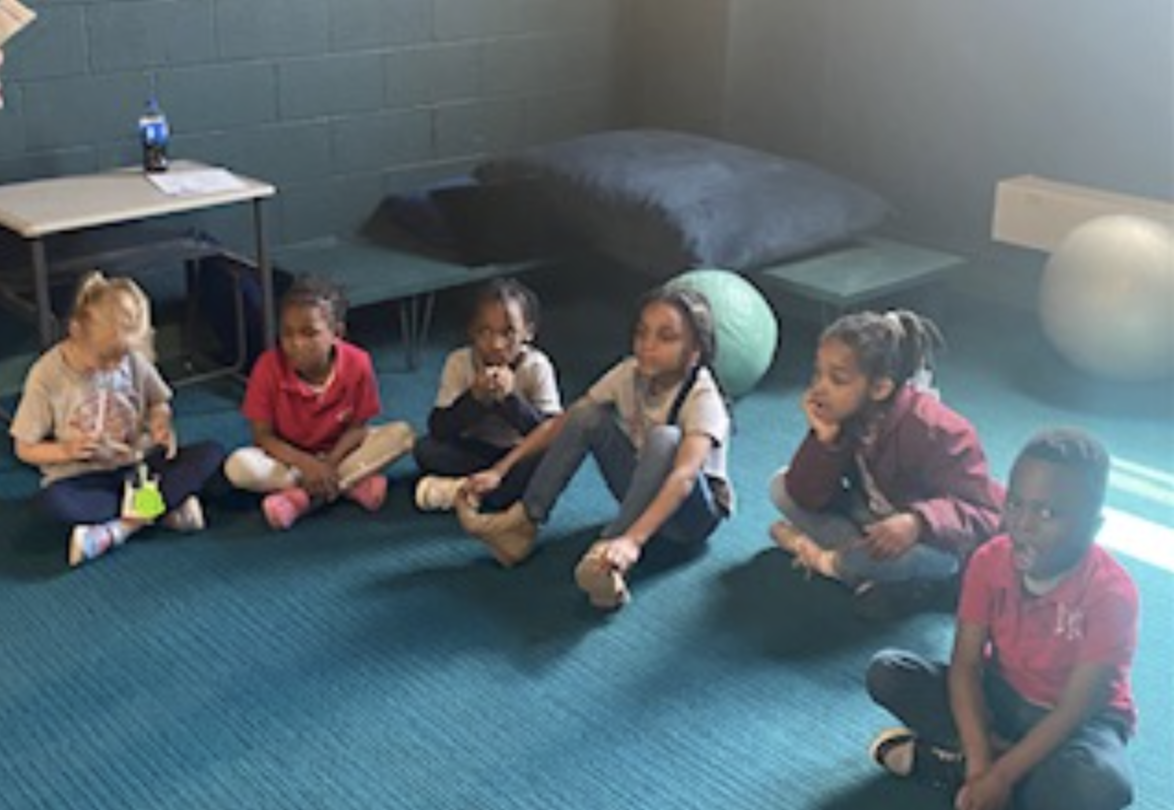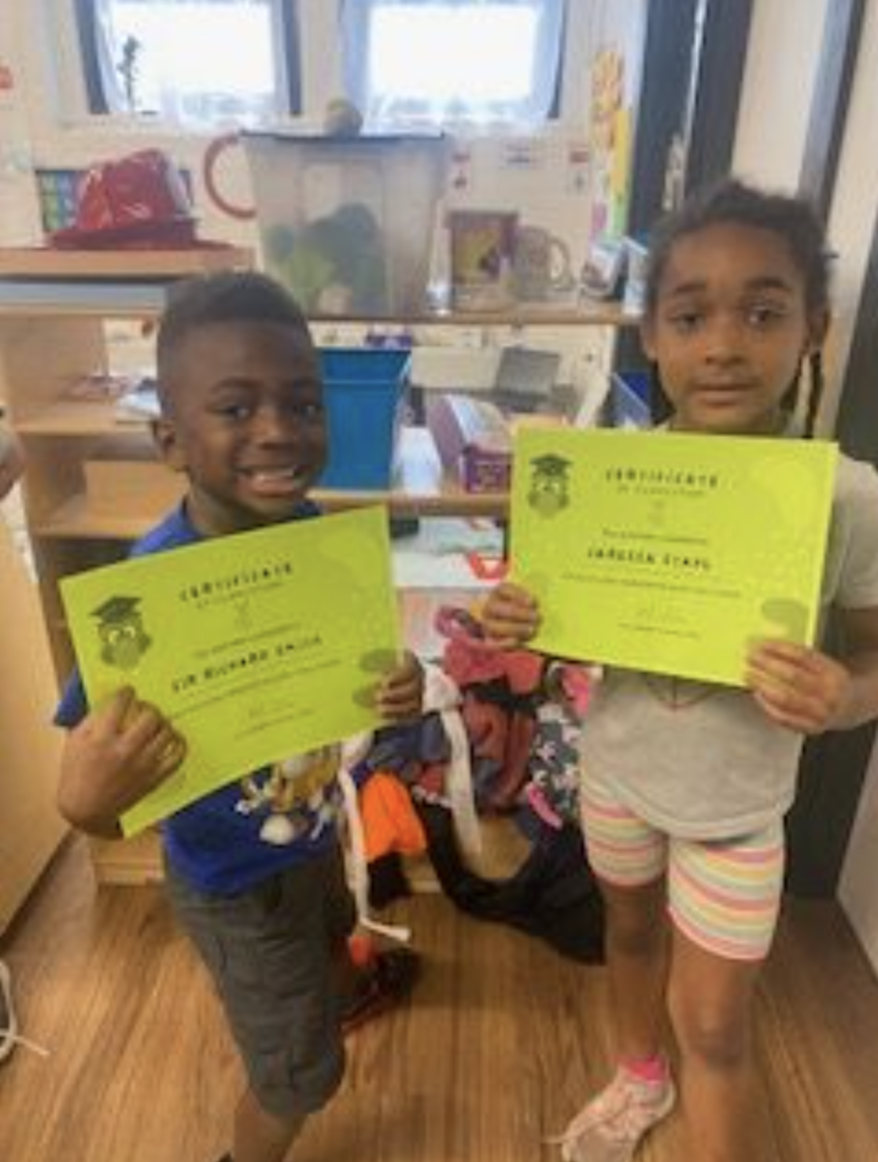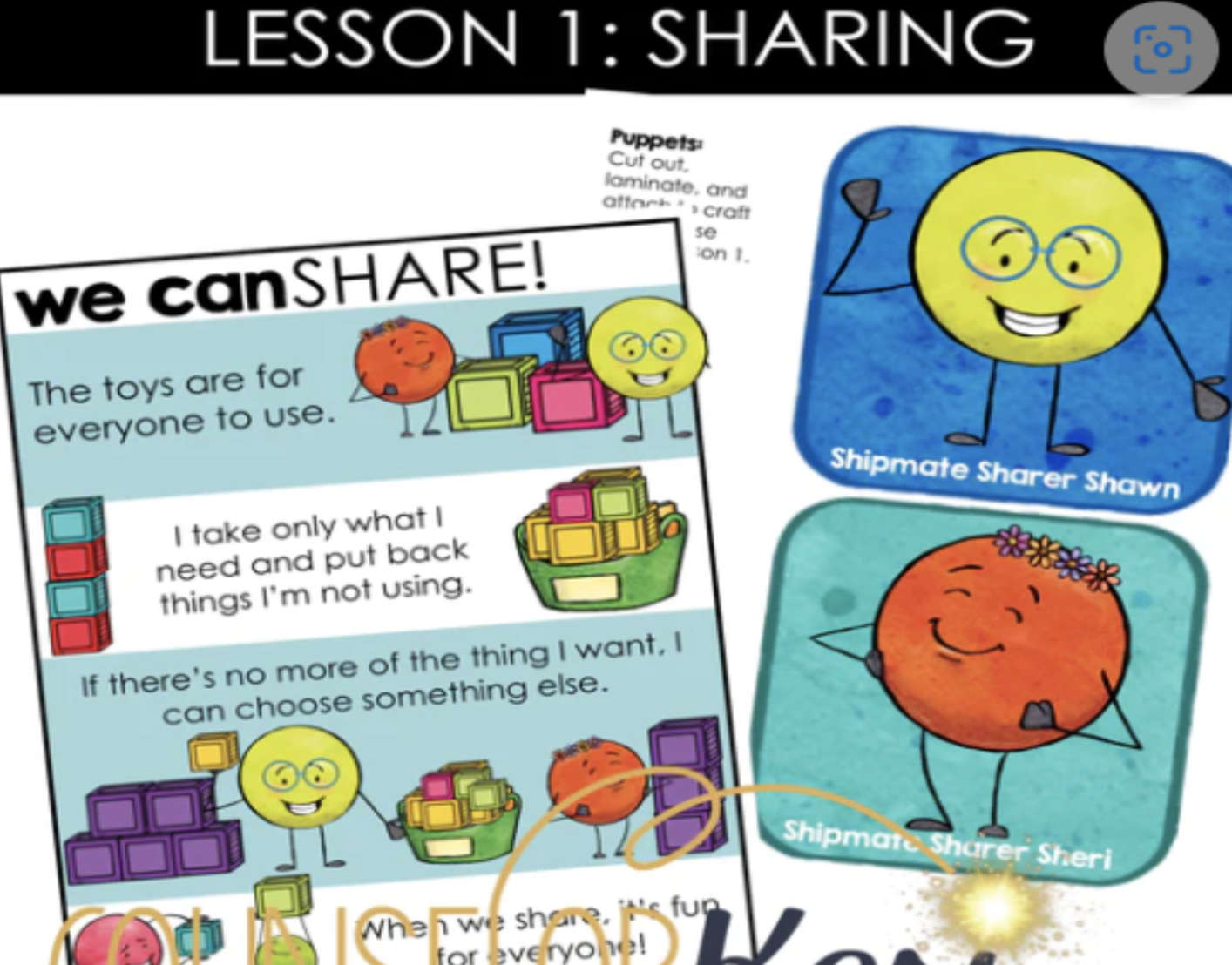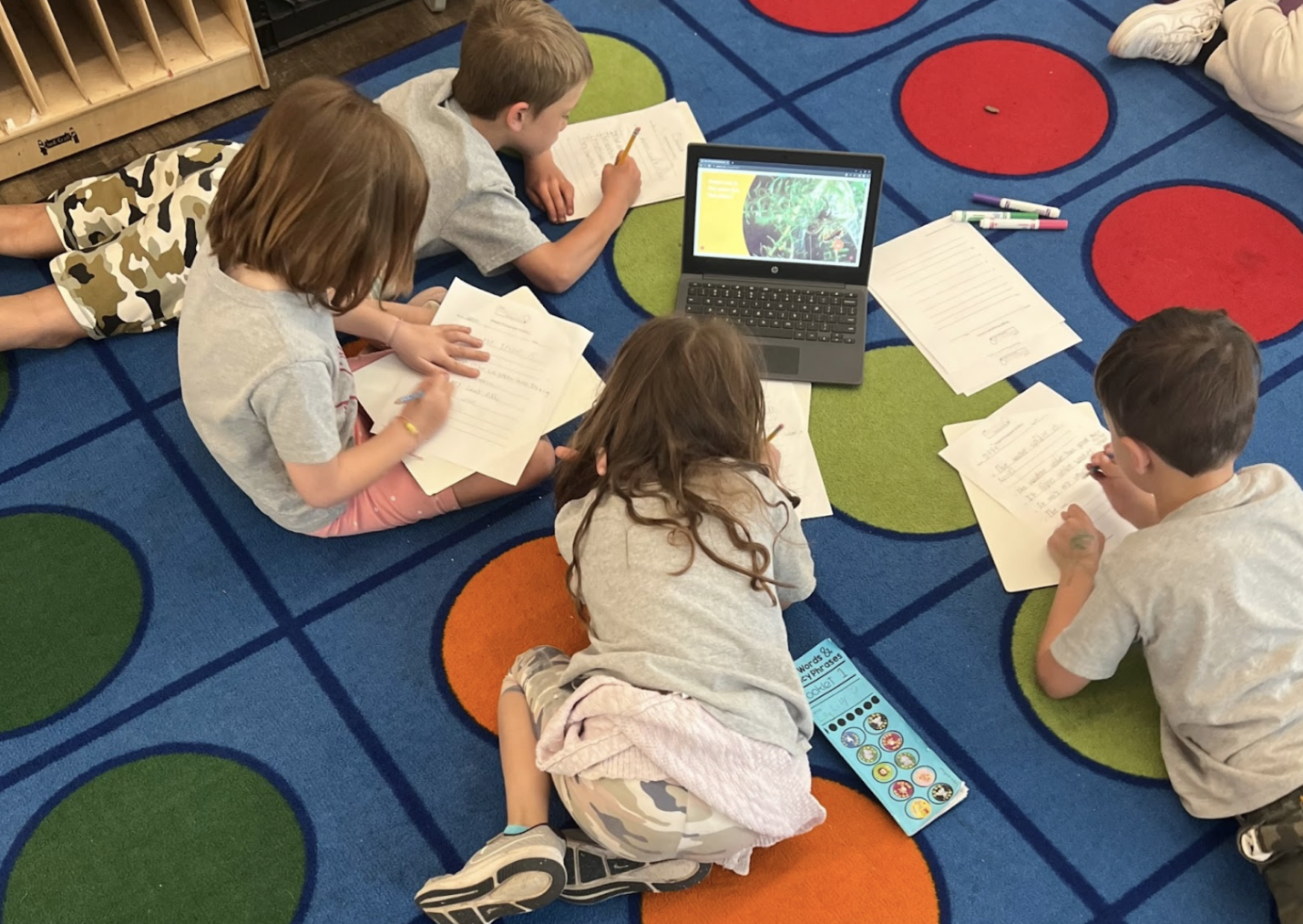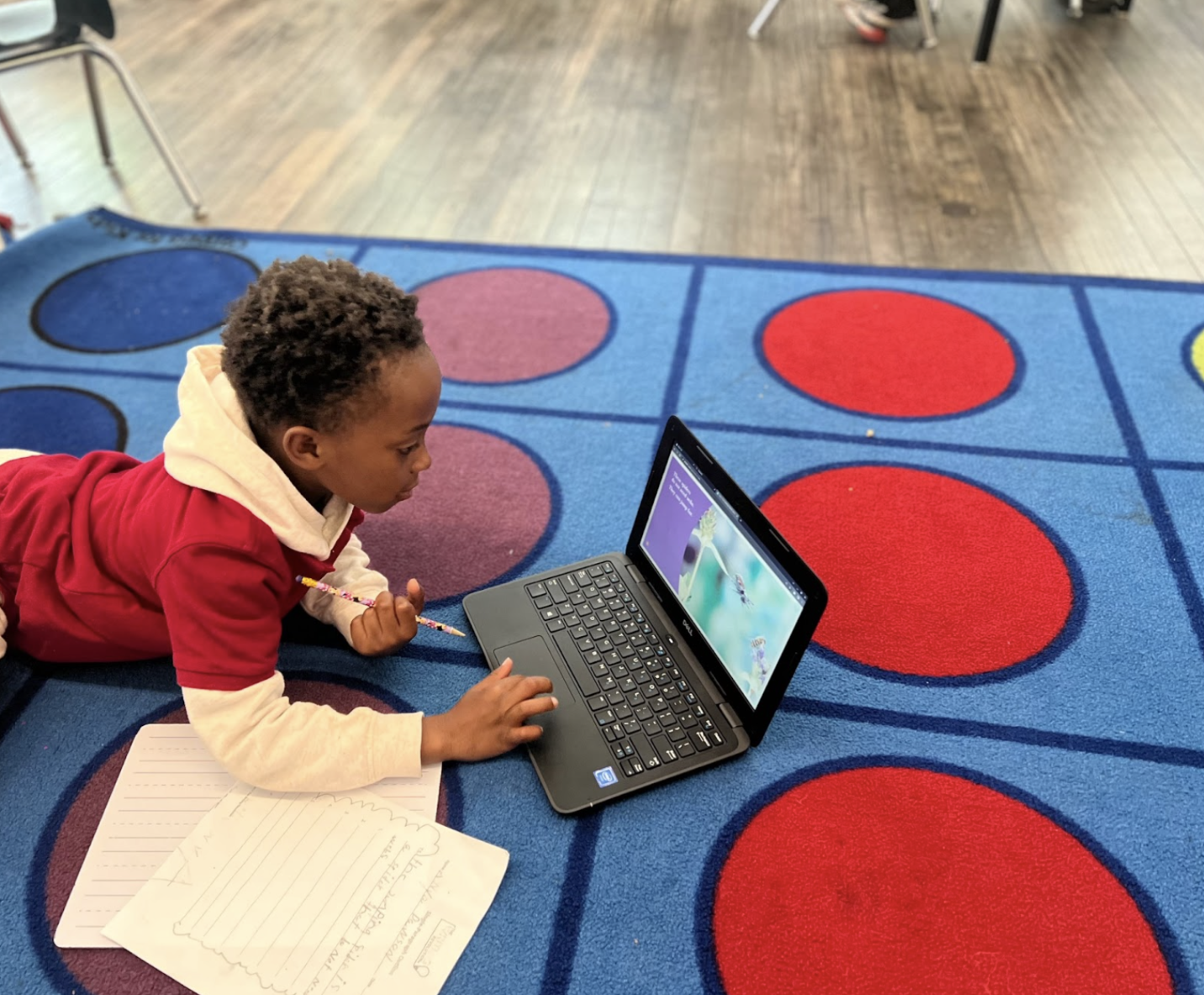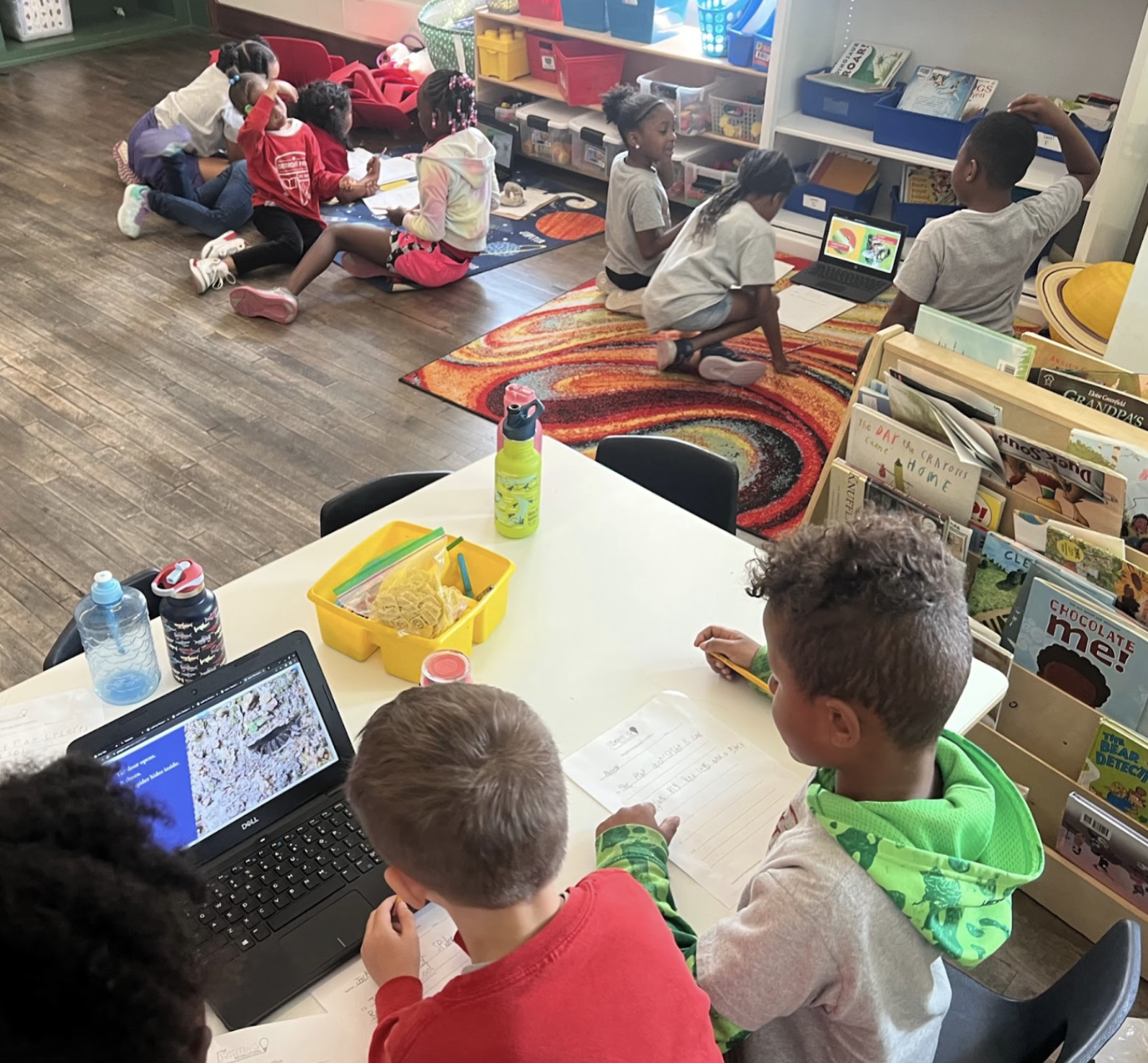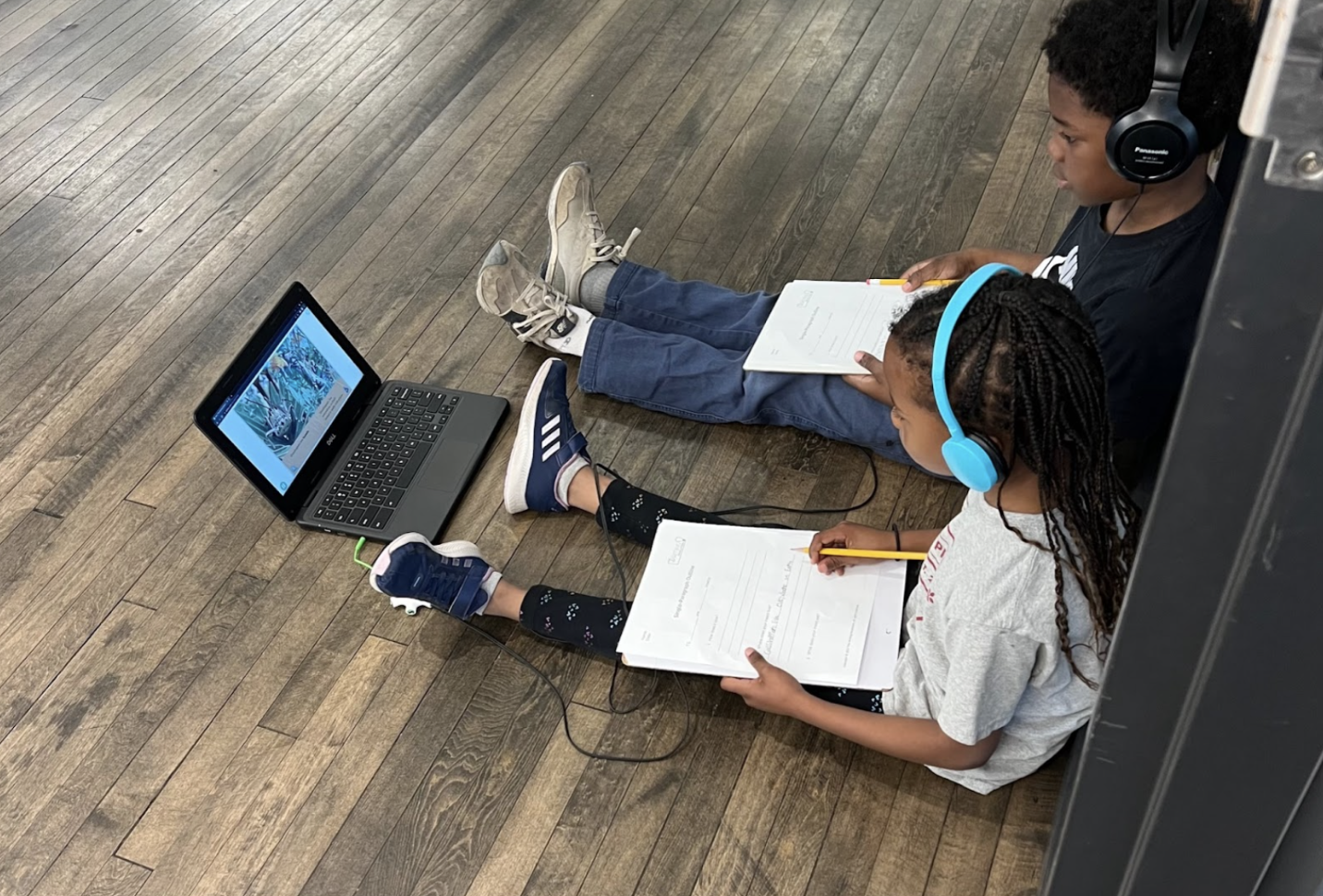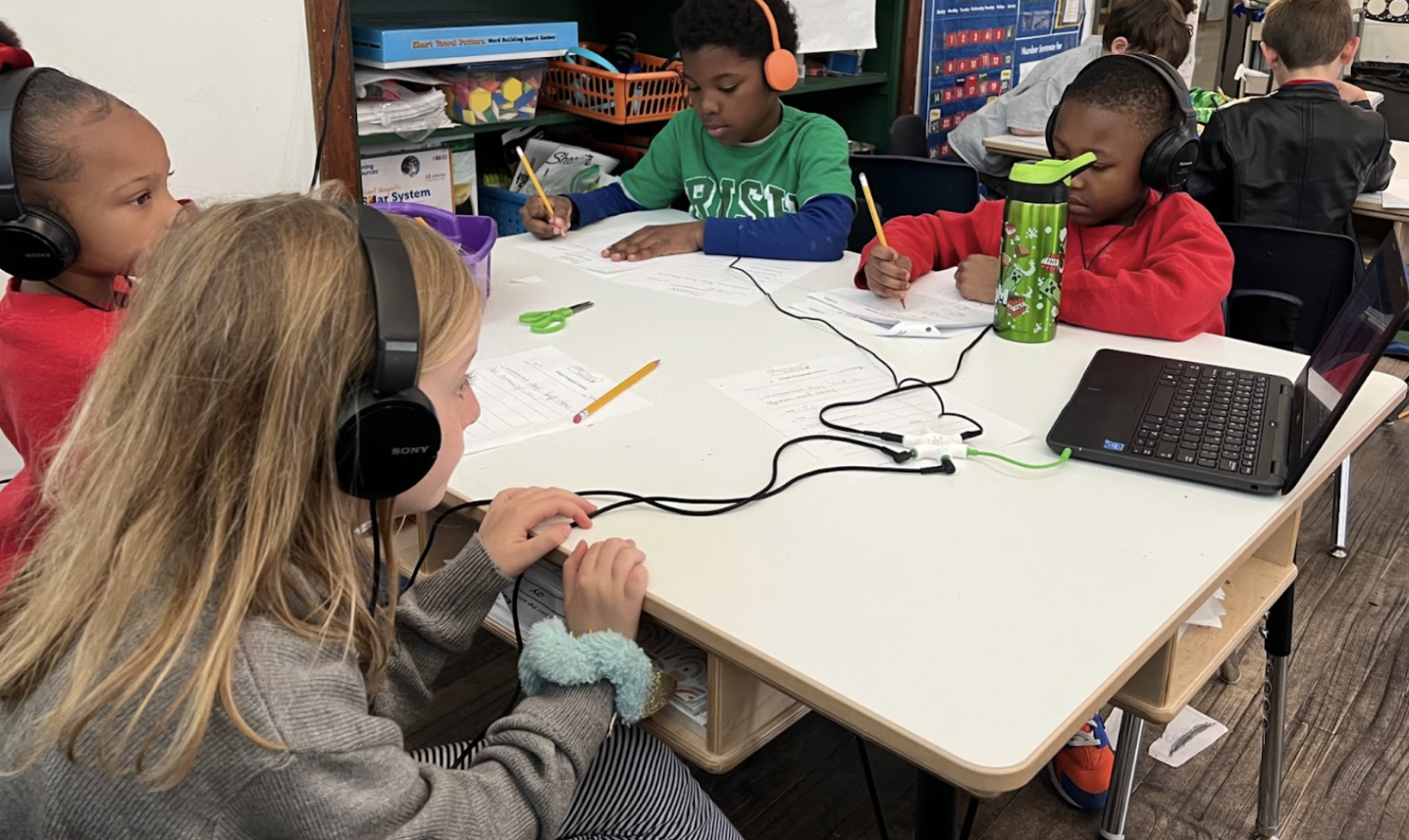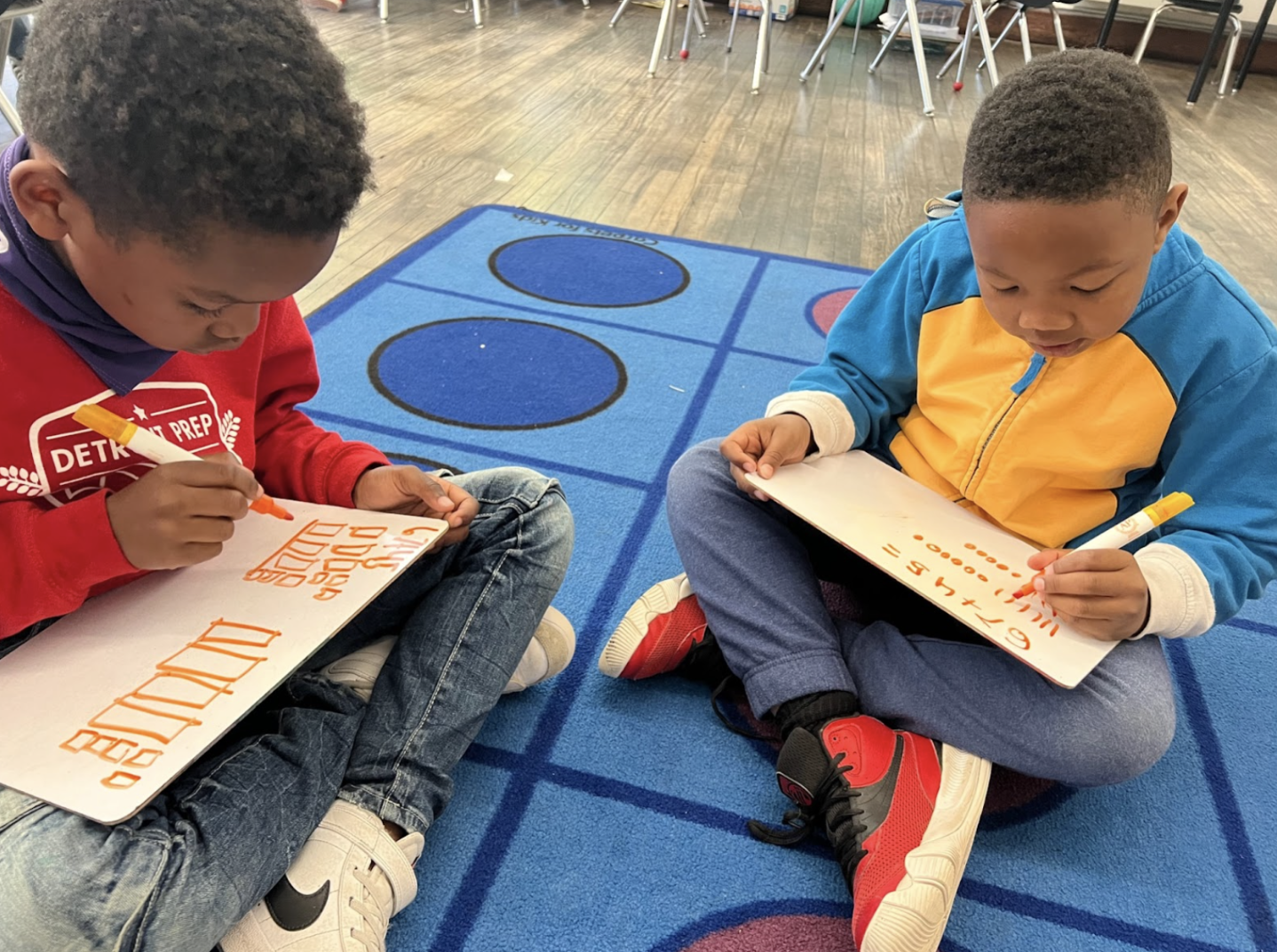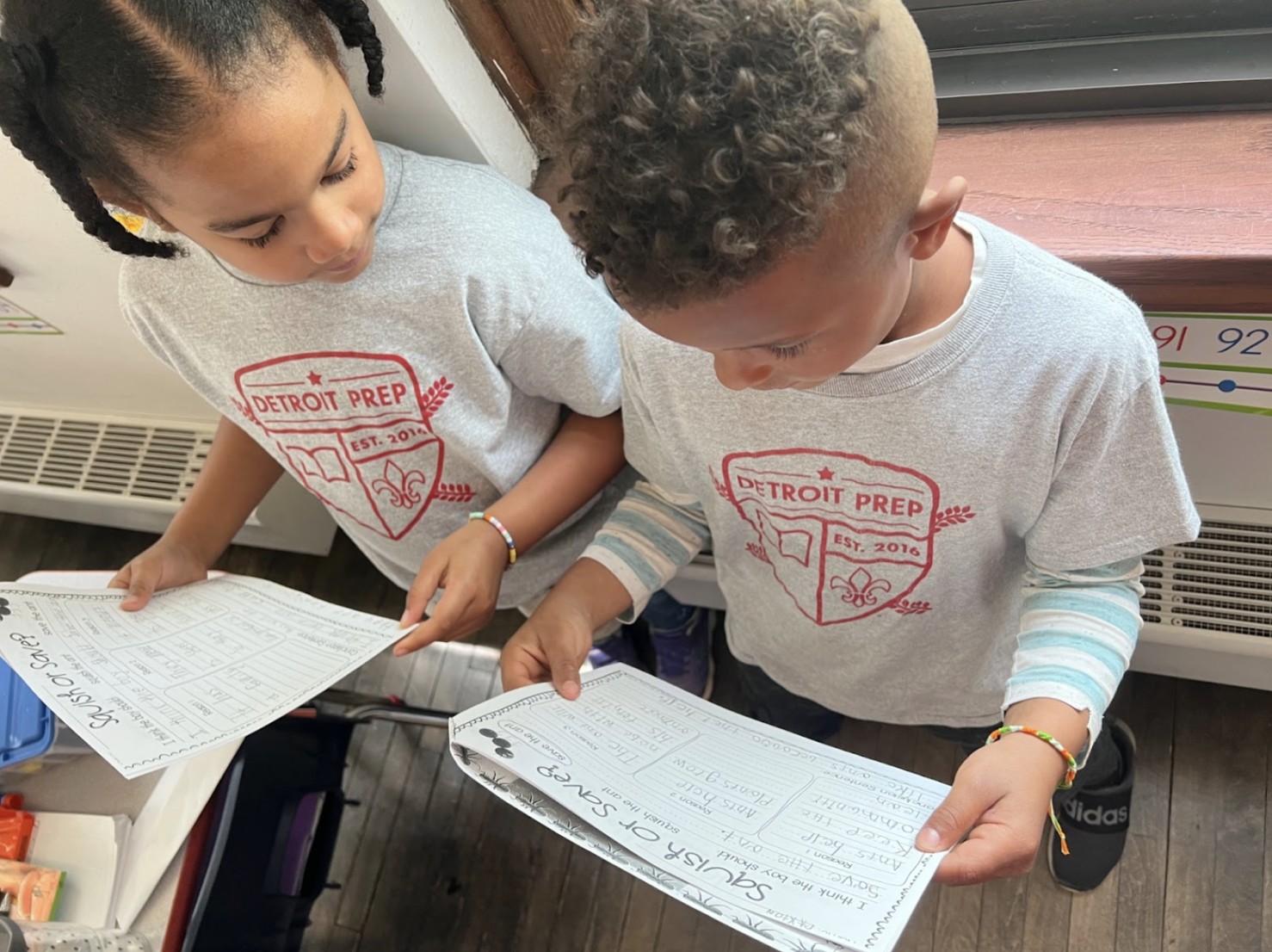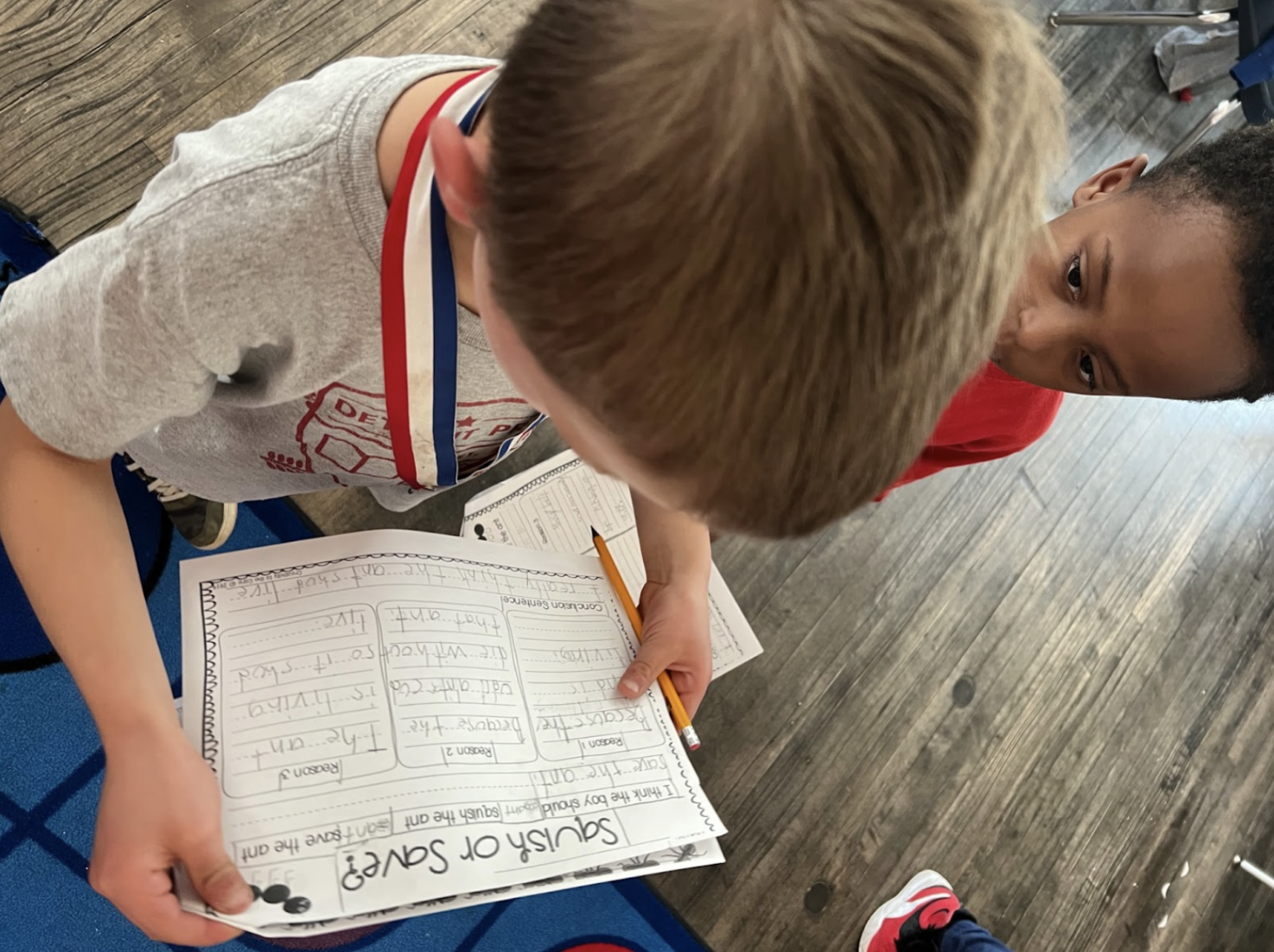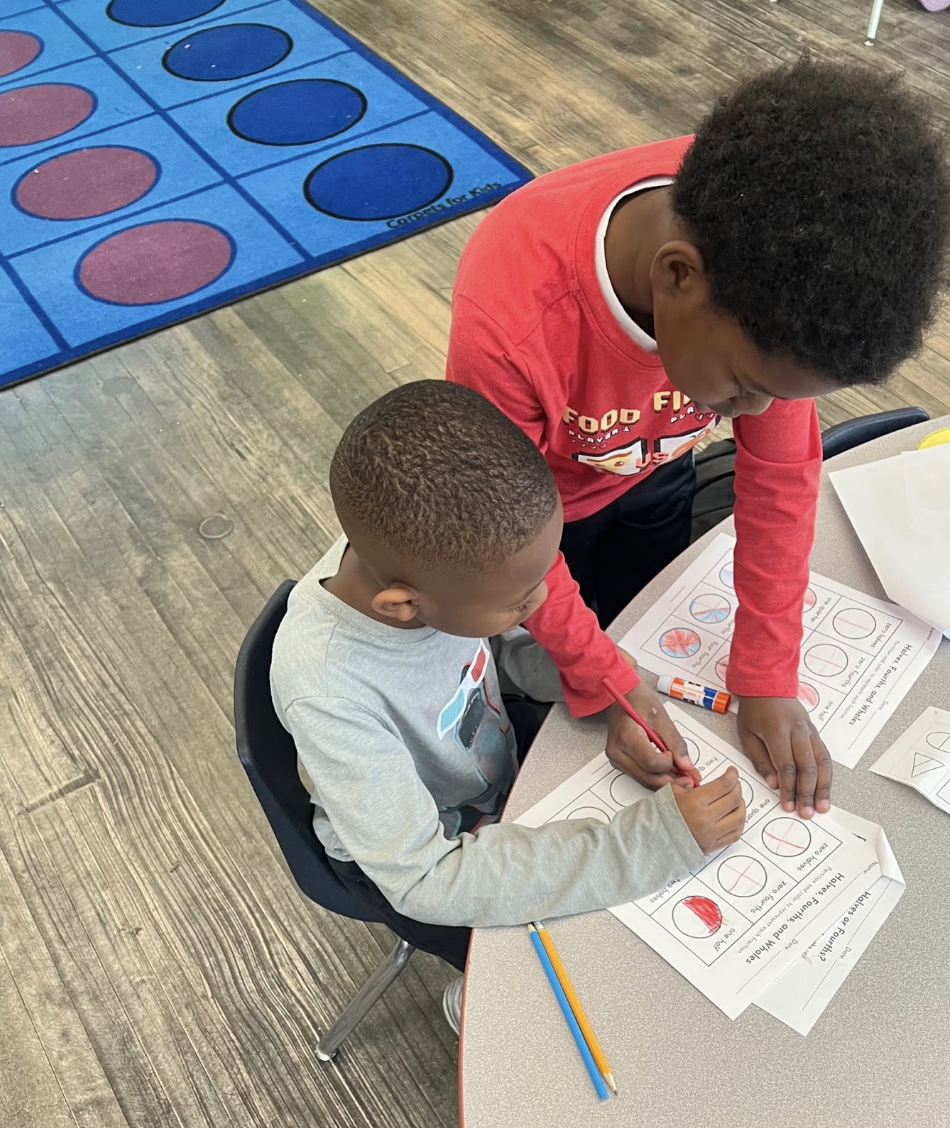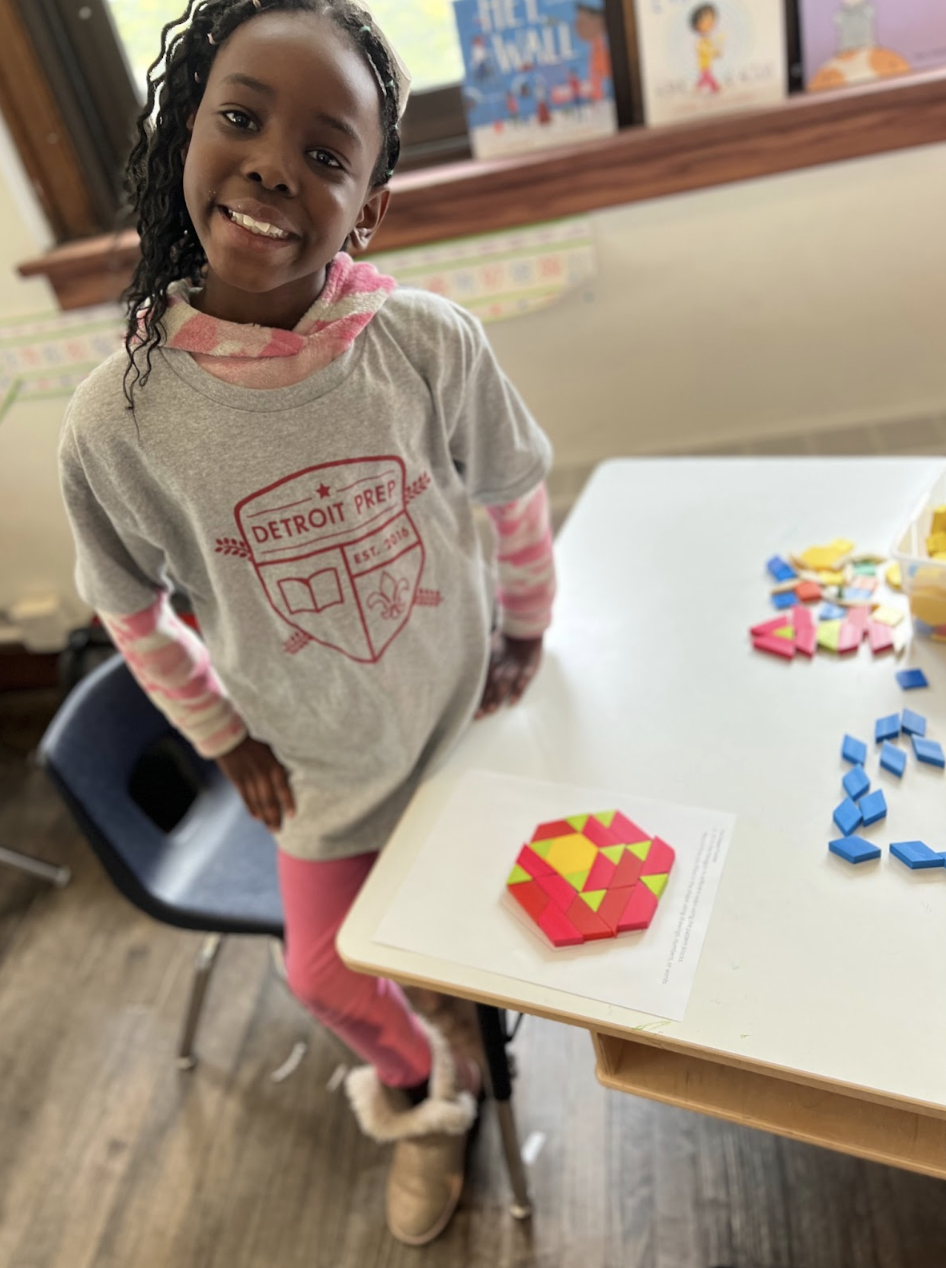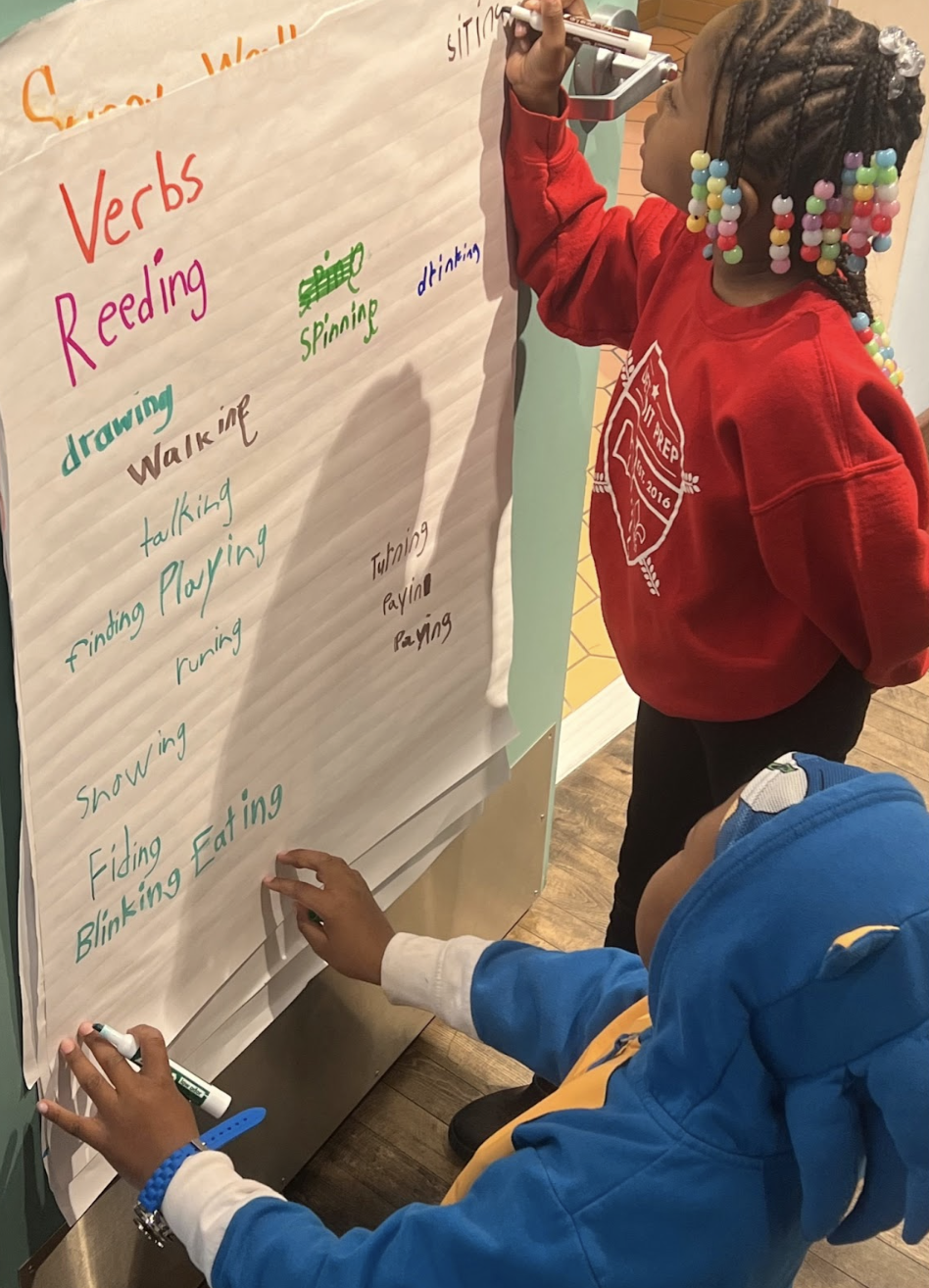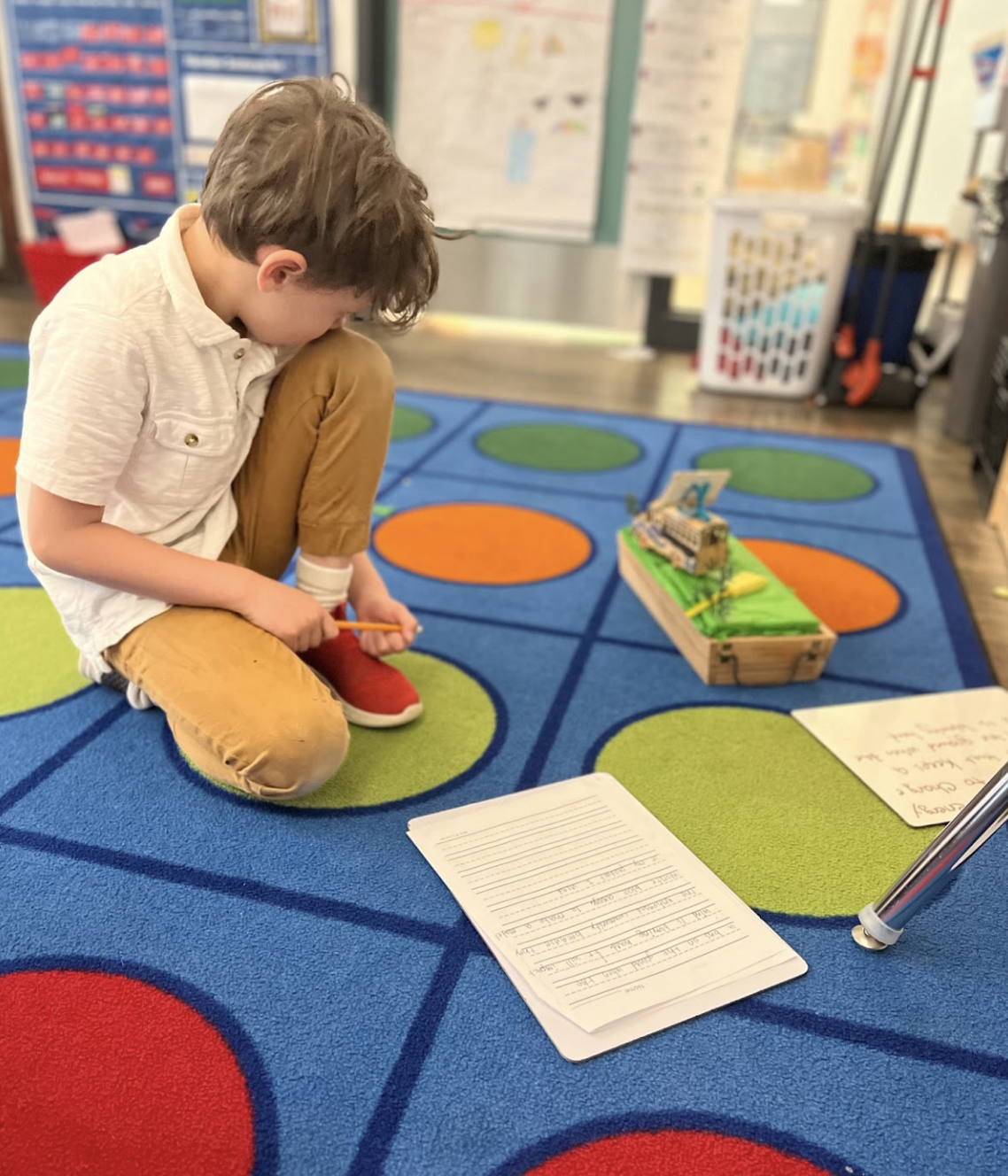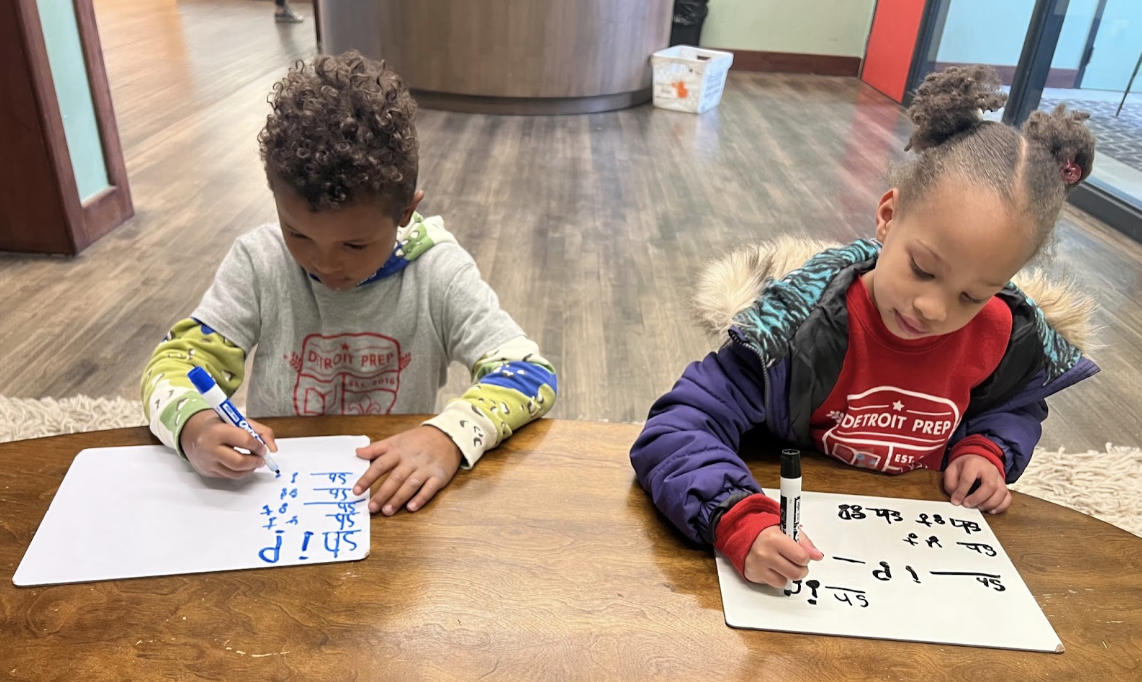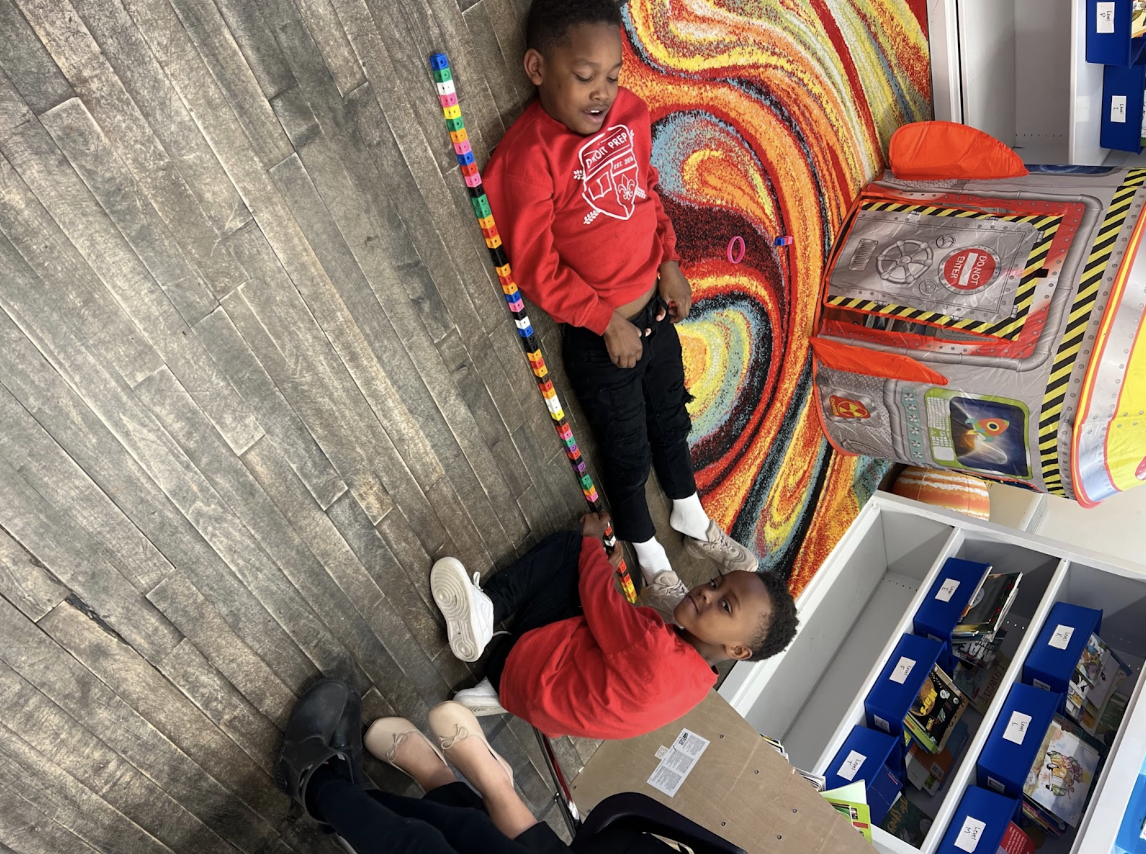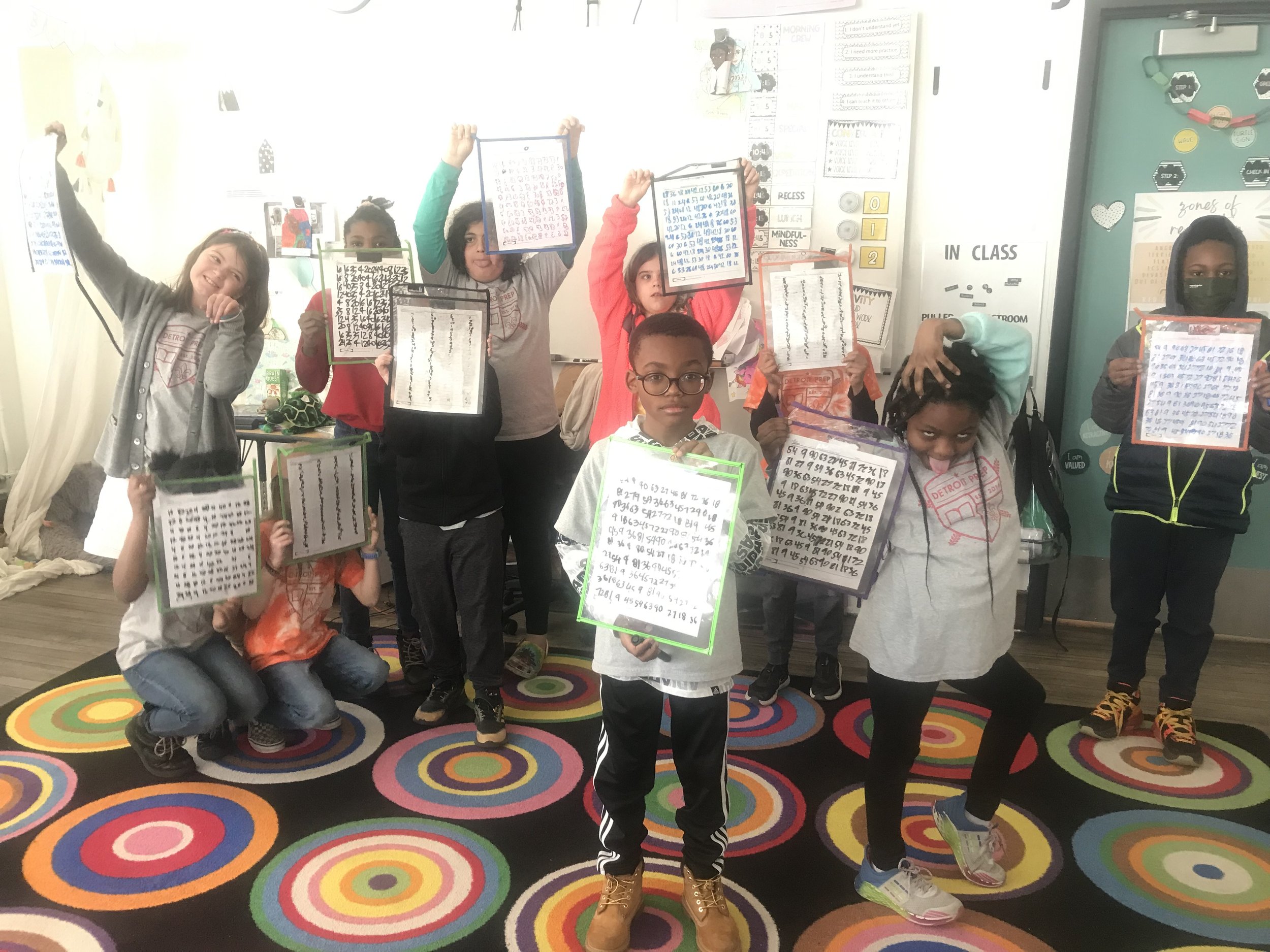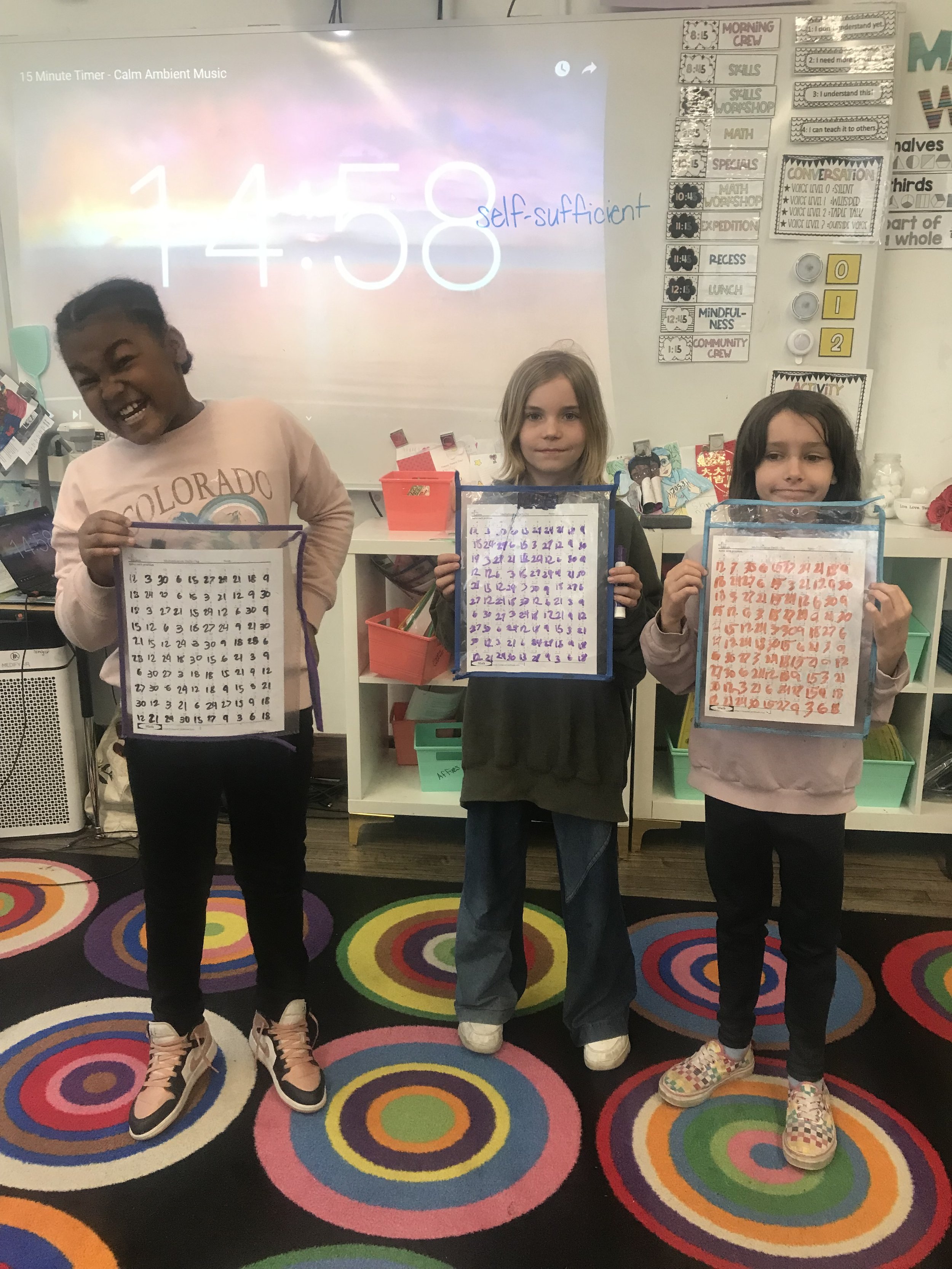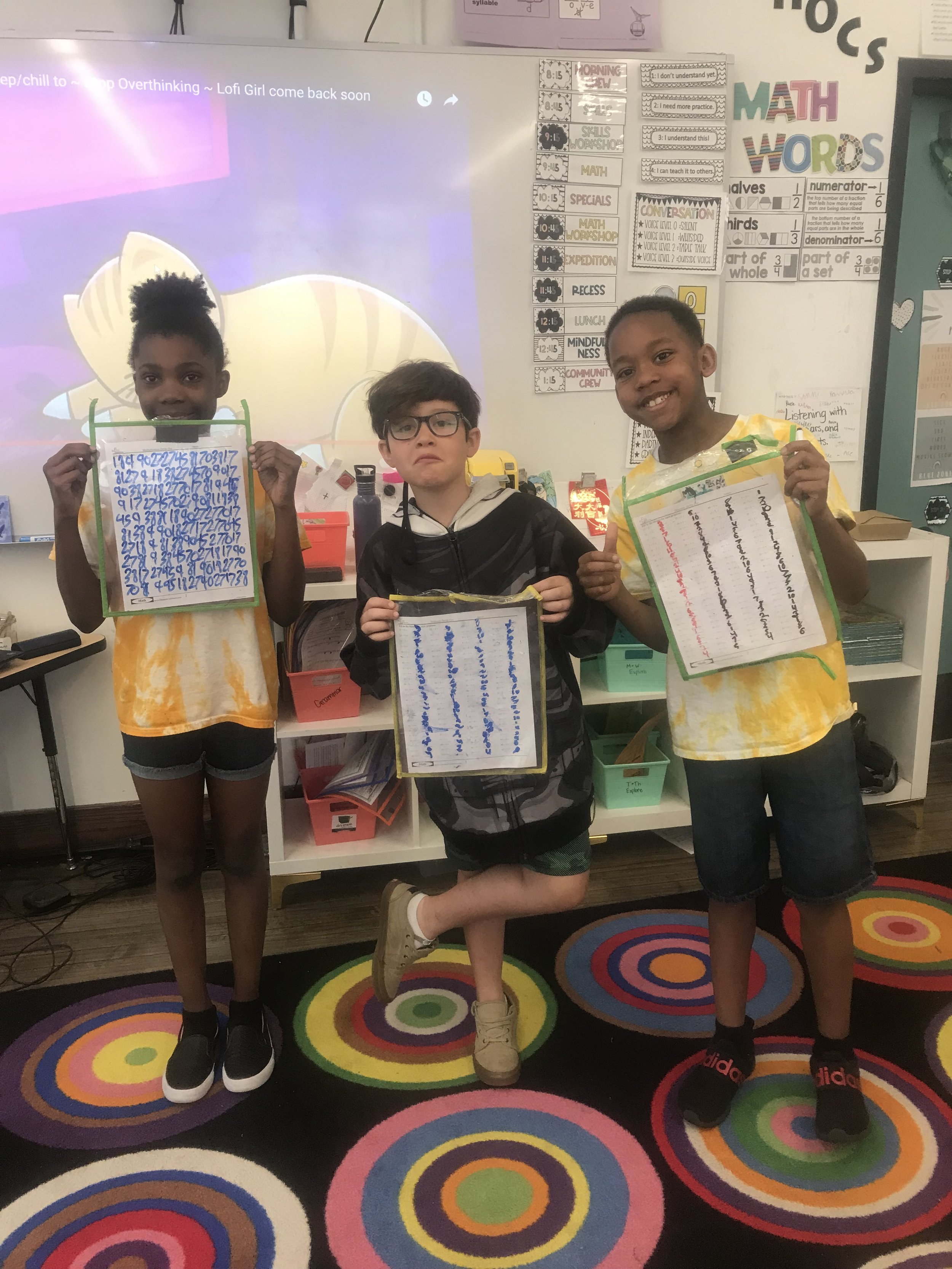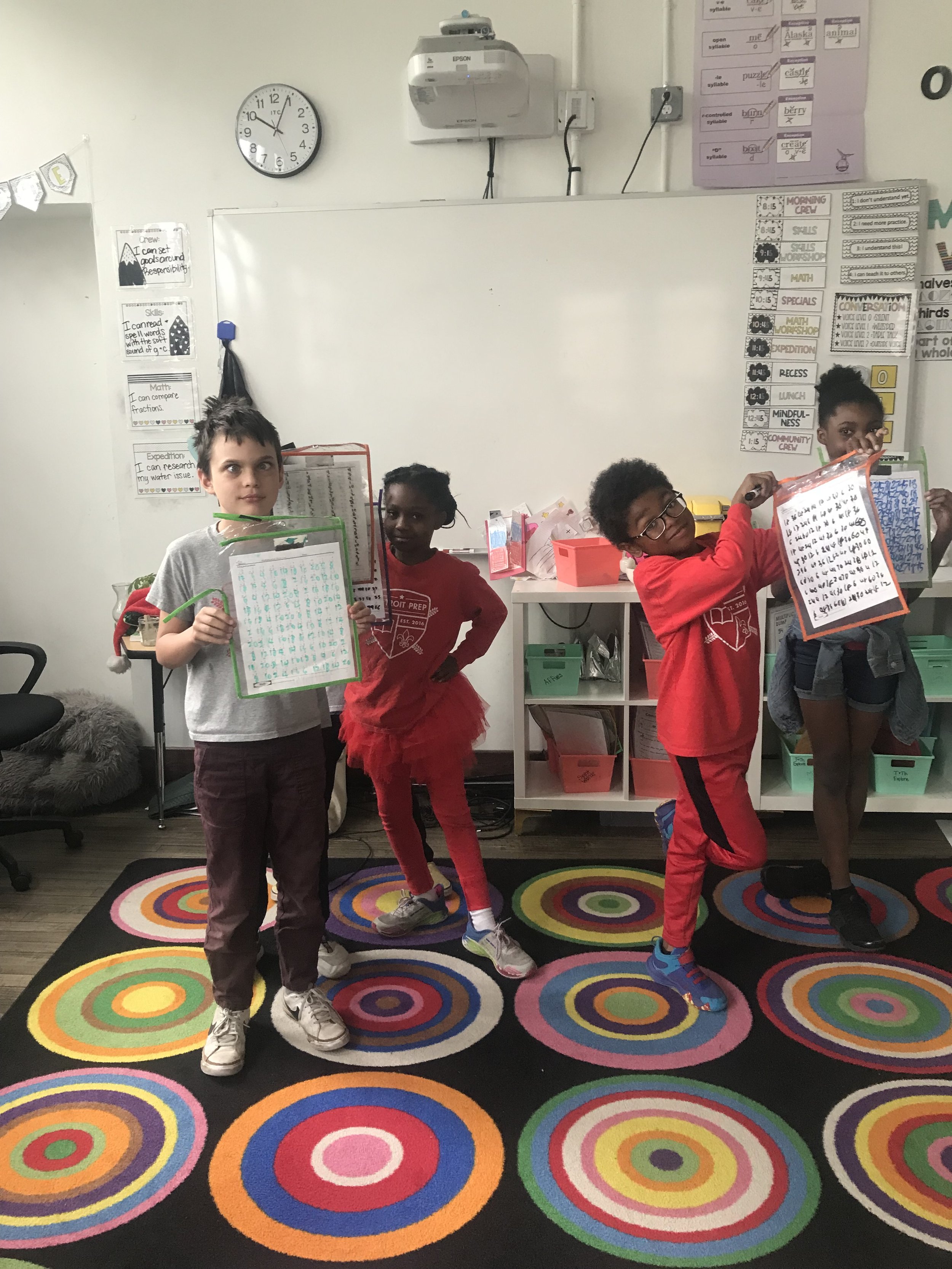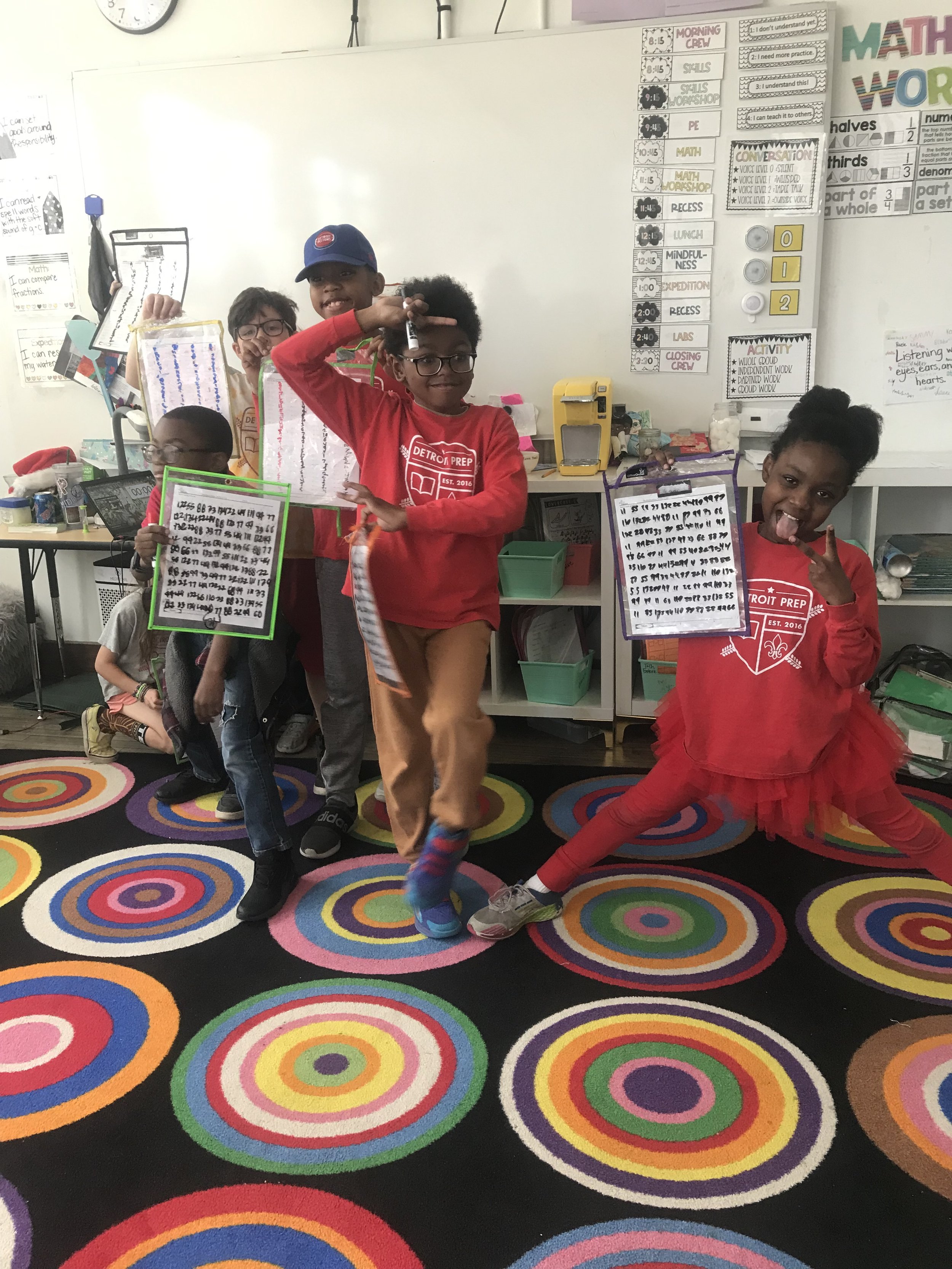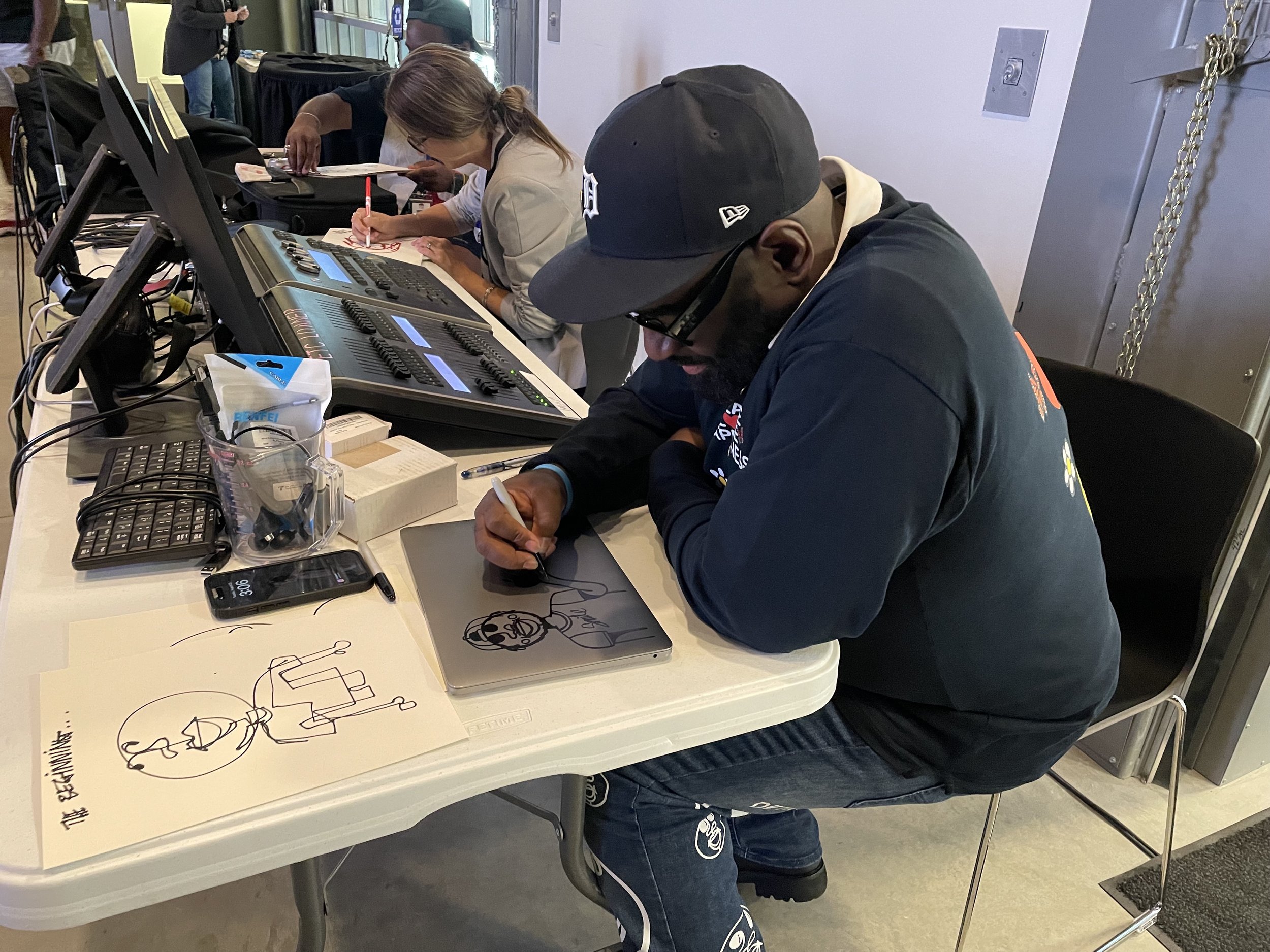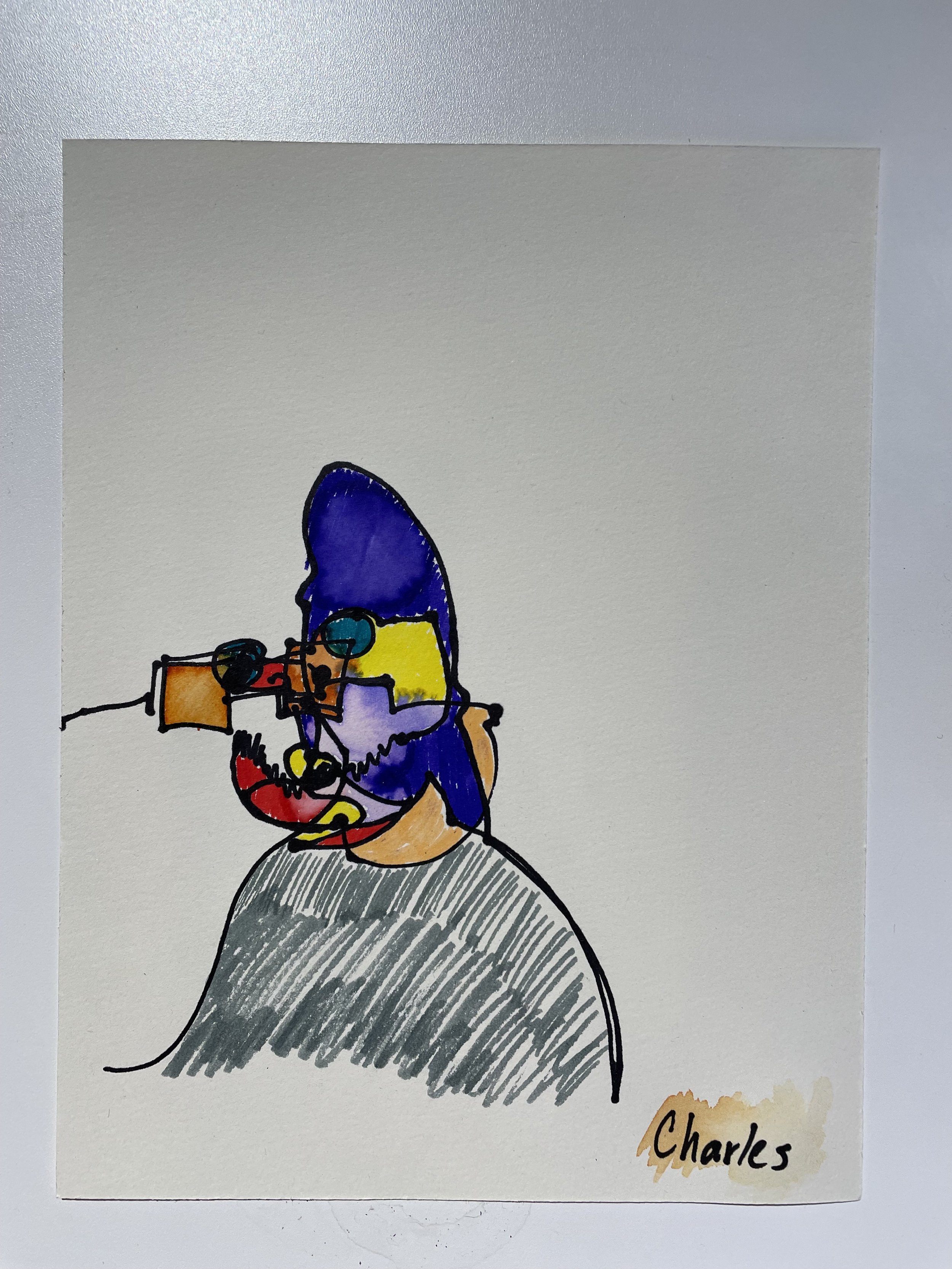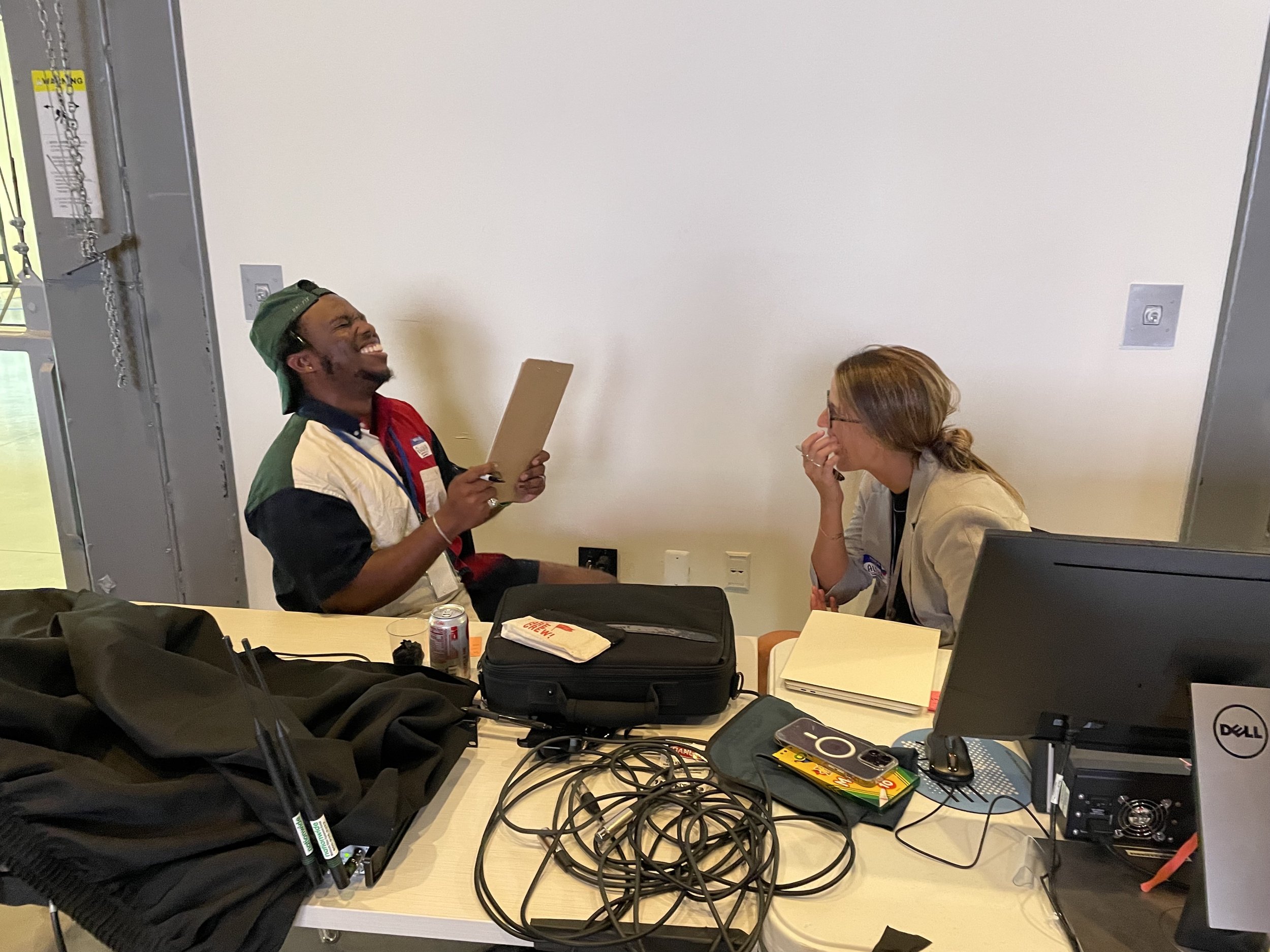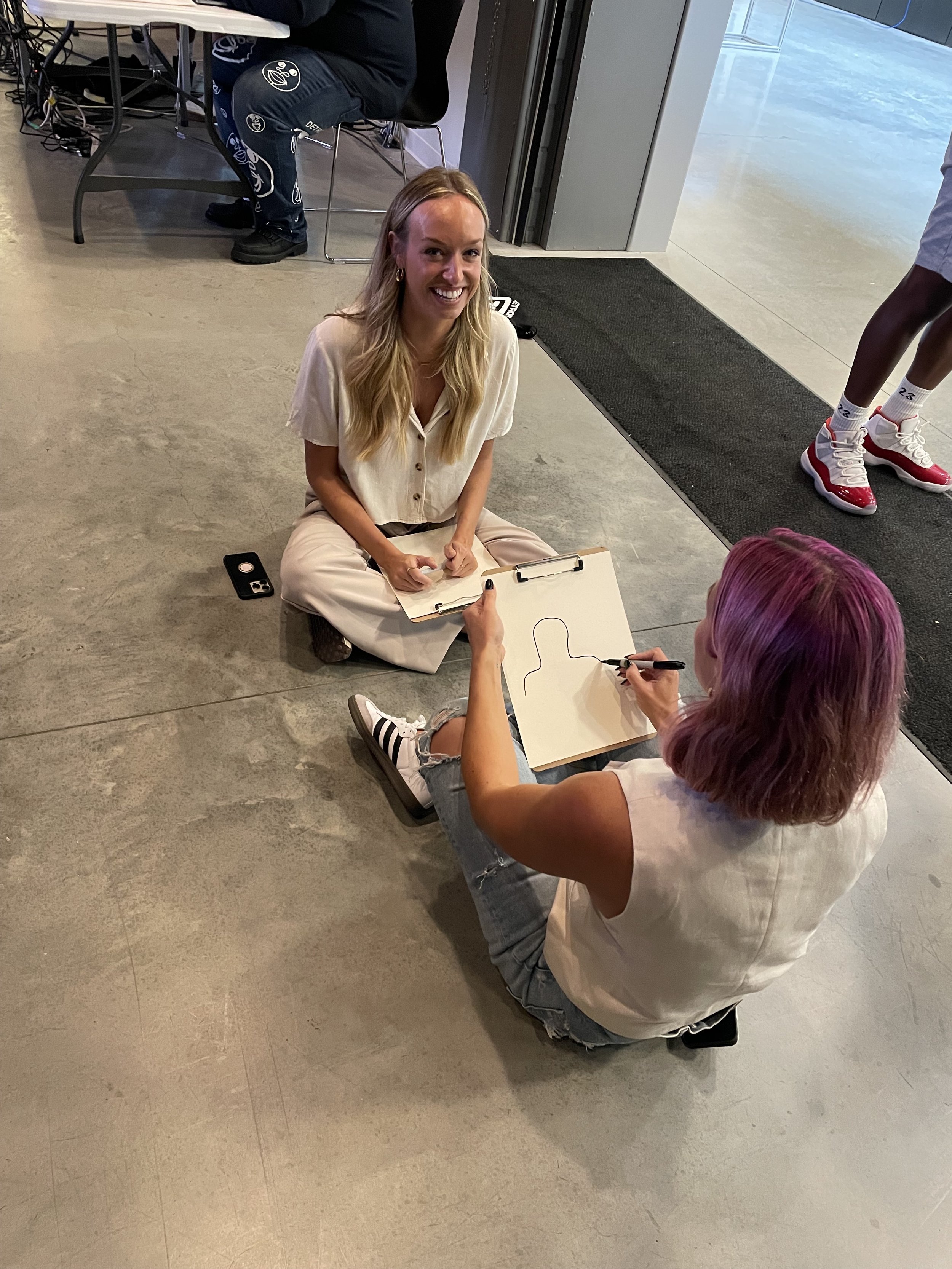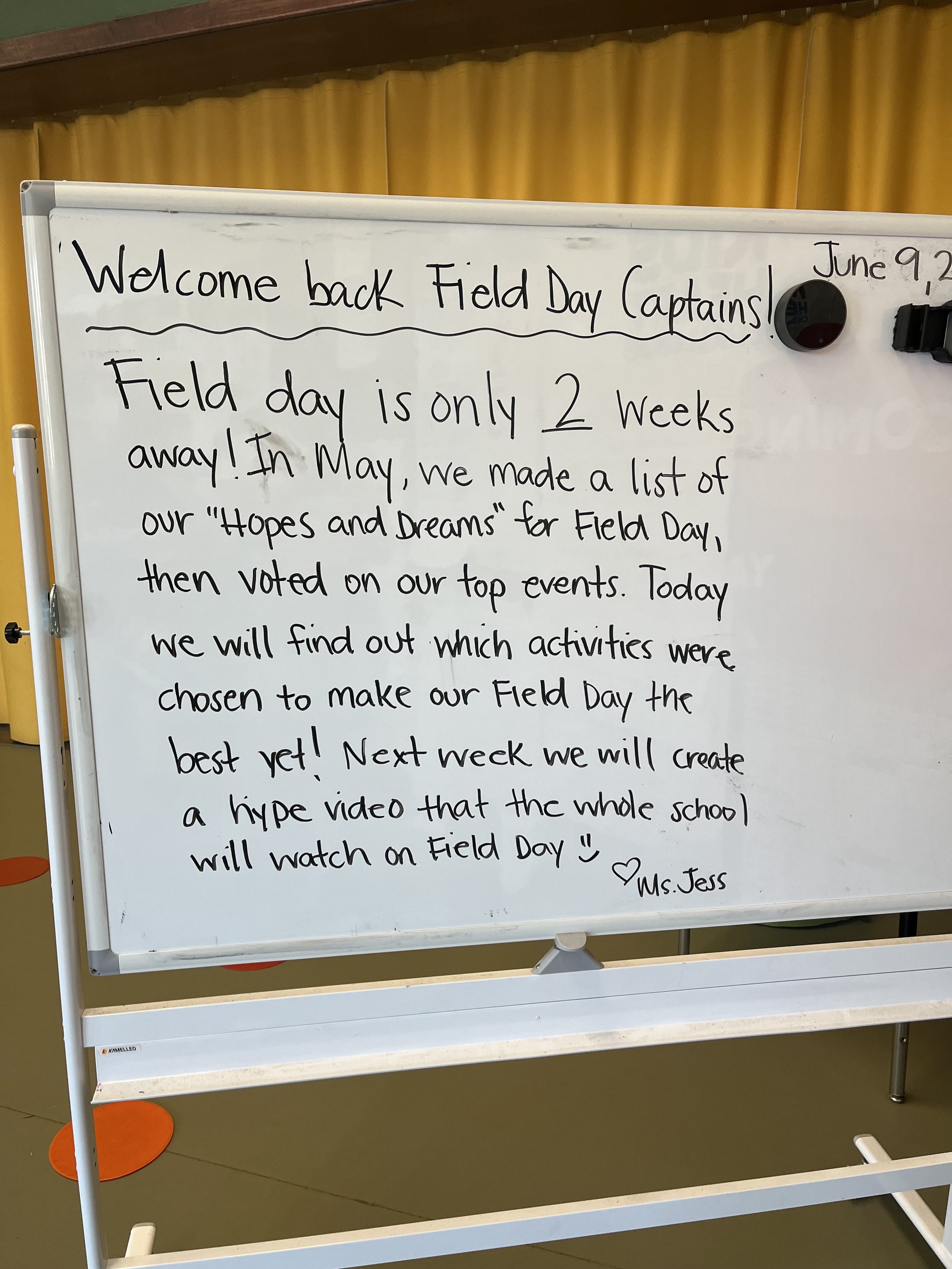Blog
It Takes a Crew
At Detroit Prep, it is truly a team effort, and all that effort pays off! I have never worked at a school that has such a comprehensive wrap-around plan for each and every student. The meetings we hold to plan for student success are so intentional and specific and include clear accountability so that all team members know their next steps and can envision the trajectory. Having classroom teachers, administrators, interventionists, support team members, and operations staff all united in vision and working towards growth both academically and socio-emotionally nurtures students in the direction of their greatest potential.
It is a joy to watch the impact of intentional structure and high expectations delivered by a staff consistently embodying the habits of character they teach students to reflect upon and internalize. To witness a student grow in confidence and capability is the truest reward of this profession, and nowhere else have I been as blessed to get to witness so much of it.
Our Habit of Character Awards
One of the highest honors at Detroit Prep is to become a Light Leader. Light Leaders are selected by being nominated by any member of our Crew - students, staff, and families - for showing all of our Habits of Character, and being a steadfast and shining example of one!
Because this honor is so special and rare, though, some students shared an idea that we should have MORE ways to recognize more students for showing our Habits of Character. This is how we came up with (drum roll please…) - our monthly Habit of Character awards!
Each month, our Primary, Elementary, and Upper School teams come together to nominate and select one student who is truly embodying each habit of character. A student is selected for each award, and Crew Leaders and Directors create a certificate to honor each student.
On the last Friday of the month, winners are announced during Community Crew and receive their certificate and acknowledgement from the community. Families are invited to attend if they are able. We are so proud of our learners, leaders, and world changers - and grateful for this way to celebrate more crew members who live our Habits of Character and make our community special!
Another way we celebrate our crew is through our weekly Crew Awards. These awards allow us to showcase our Habits of Character as a team, and each Crew (classroom) works together to win every week! Our four awards are: Silver Seat, Golden Lunch Tray, Team Spirit, and All-Star Attendance!
Silver Seat: This is award goes to the floor with the cleanest restrooms where students are showing integrity while using the space. Winners get chosen to play our Community Crew game on Fridays.
Golden Lunch Tray/Cleanest Crew: This award is for the cleanest, most responsible and compassionate crew during lunch. Winners earn lunch coverage for teachers, choosing seats during lunch after five wins, and a pizza party after 10 wins!
Team Spirit: 100% of students in uniform means free dress on Friday!
All Star Attendance: Crews with the highest attendance percentage for the week earn an additional recess on Fridays with Ms. Jen (and an extra 30 minutes of prep for their teacher!)
These awards build a sense of pride in our community, engages us in friendly competition, and generates team spirit. We are CREW!
Social Skills for Kindergarten Success
Kindergarten is a big transition for children. The expectations are new and some of the social interactions are new. At Detroit Prep we want children to share, take turns, make transitions, and so much more all while learning new academic skills. To help make the transition easier for kindergartners, we practice 6 social skills that contribute to school and social success!
Sharing: This kindergarten skill is important for Kindergarten success! Students spend a lot of time in freeplay with their peers and working alongside one another. Sharing toys and materials is a must.
Taking Turns: Taking turns goes hand in hand with sharing, but there’s a distinct difference. When we’re taking turns, one person is using an item while another person waits.
Accepting No: Sometimes children will hear no, especially when at school. Sometimes, they might ask for a turn with something and someone might say no. Accepting no is another important social skill for Kindergarten. Students are taught calming strategies to use in the moment when they experience dissappointent, frustration, or anger over a no answer.
Listening and Following Directions: Listening and following directions are huge skills for not just Kindergarten success, but school success as a whole. Students are taught what listening looks and feels like. (Eyes on the speaker, body still, mouths closed, hands empty, and ears ready to listen).
Stating Needs: Need some personal space? Ask for it with words. Need help? Let an adult know. The phrase “use your words,” comes up a lot in Kindergarten as we want students to be able to advocate for themselves. Practicing asking for a break, some space, or help is big for Kindergarten success!
Transitioning Activities: It’s hard to stop doing something we enjoy and move on to something new! We can help students tune in to transition signals like teacher reminders, visual calendars, and timers. When it is hard to move on students are taught calming strategies.
Using Data for Equity
At Detroit Prep, we believe in our mission of providing a world-class, equitable education that will give all students a foundation of academic excellence and character development. We often ask ourselves - what does it look like to measure our progress toward this mission?
To answer this question, this year, I participated in a Community of Practice through the Diverse Charter Schools Coalition on Using Data for Equity. Diverse Charter Schools Coalition is an organization that supports schools working toward true integration.
In the fall sessions, we spent time assessing and reflecting upon our personal relationship with data and the systems and processes that exist at our school and others in the Community of Practice. We continued our analysis to unpack ways in which we assess growth and progress towards achieving racial equity in our respective school communities. Finally, we explored our personal connections to data.
In the second half of the year, our focus shifted to designing our own research questions:
How might we create a database of achievement and behavioral data that can be disaggregated by race, socioeconomic status, free lunch, and gender to identify and address any disparities in academic and behavioral outcomes among different student groups?
How can we use data to inform and guide decision-making processes, allocate resources more effectively, and ensure accountability for providing equitable opportunities and outcomes to all students?
How can we use data to design and target effective interventions for historically underrepresented and marginalized students?
Having access to this data promotes transparency and understanding of the experiences and needs of different student groups, which is an essential step in creating a more equitable educational system for our students!
Our next steps are to identify the data to be collected: which academic and behavioral outcomes to track and which demographic variables to use as categories of analysis (e.g. race, socioeconomic status, free lunch, gender, etc.) and then develop a data collection plan. Stay tuned for more updates on how we use data for equity.
In the meantime, take a look at how our intentional use of data and learning modalities has impacted the learning experiences for students at Detroit Prep!
Fluency in Five: Fridays in Turtle Crew
One of the paramount standards in the third-grade math curriculum is fluently reciting all fact families of factors 1-10. When students come to Turtle Crew, they usually have a solid grasp of their 2s, 5s, and 10s. However, the area around each of those digits gets a little hazier as students grasp for 3x4 or 7x8. Teaching fluency can be pretty boring: rote memorization, flashcards, drilling students. You probably have less-than-fond memories of each of these activities from your grade school years.
In Turtle Crew, we tried a different approach this year called Fluency in Five. Fluency in Five is conducted for five minutes every Friday, and it is something that we practice for throughout the week. Scholars have at least 20 minutes of fluency practice every day in preparation for their Fluency in Five competition. Who are they competing with? Themselves.
Each Fluency in Five Friday, Turtles have five minutes to complete 100 facts from a given fact family. At the beginning of the year, scholars are given facts of 2s and 5s fluency tables in a dry-erase pocket. Each pocket has the scholar's name on it, and it becomes their fluency folder for the year. Each week, Turtles choose a fact family in their fluency folder to try to master; at the beginning of the year, for example, each Turtle works on either 2s or 5s for the week.
During the Fluency in Five, each scholar has five minutes to complete their given set of facts. If they ‘graduate’, they are able to complete 100 facts of their fact family before the five minute timer is done. Those that ‘graduate’ then come to the carpet for their quick ‘graduation’ photo, and start the next set of facts in their folder the following week. If they have ‘graduated’ from both sides of their fluency folder, they can return that set of facts, and move on to the next one. For example, if Turtles ‘graduate’ from 2s and 5s after the first weeks of school, they would then return those fact families and replace them with 3s and 4s. Once they ‘graduate’ from 3s and 4s, they move on to 6s and 9s, and finally to 7s and 8s.
Why does Fluency in Five work? Well, it turns out that 3rd graders love having goofy photos of themselves taken (even if it means hiding from said goofy photo). They also love supporting one another, whether it is celebrating wins or encouraging those who didn’t quite ‘graduate’ that week. It also involves families in the process. Caregivers are sent the photos weekly to see whether their scholar is a ‘graduate’ this week. It holds scholars accountable for their learning within the classroom and at home as well. The positive reinforcement from home has also motivated scholars to work on their facts at home; I’ve had more requests for fluency tables this year than ever before!
From a teaching standpoint, Fluency in Five is also a sustainable way to monitor progress and provide the right cognitive load for your students. Each week, you can see which scholars are ready for the next step and which need more support from you to master their facts. In addition, scholars can be responsible for their learning during Fluency in Five, each time a scholar ‘graduates’ they then go to our “Fluency” wall and pick the next set of facts. If you have scholars that master their multiplication tables, they can move onto division. Mastered division? Move on to fractions or decimals. The possibilities are endless, and the choices always center student voice.
Want to give it a try in your Crew? Build the foundation first. Mistakes are great, and we love to learn from them. Build a supportive community where scholars feel willing to try their best and fall down sometimes. Answer any questions they may have, and make adjustments as you go. This year, we had a meeting after each Fluency in Five to see what we wanted changed. We went from music to no music, timer on the board to timer off the board, no verbal time warnings to one-minute verbal warnings. And remember to accommodate all learners. Some may need additional time. Some might need an adjusted seating arrangement or manipulatives. Make it work for your Crew and your learners. And, most importantly, have fun!
Daily Art Integration
In August, the staff at Detroit Prep and our sister school, Detroit Achievement Academy participated in a professional development session on integrating art into the classroom every day. The session was facilitated and planned by myself and the DAA art teacher extraordinaire, Erin Brott. The hour-long session followed a question and answer session with local superstar artist Phil Simpson, who stuck around after his talk to create some art with us. It was the most joyous and creative afternoon.
The reason Erin and I wanted to put together this PD session is to ensure and support all of our staff in having art planning tools so that they feel comfortable creating more art with the students in their Crewrooms. To do that, we decided we wanted to teach the teachers an art lesson that they could teach to the students. Some of the things we considered were the materials available, level of difficulty of the art making we wanted to share and how engaging the students would find the lesson. We landed on the art practice of Blind Contour Drawings.
Blind Contour Drawings are an exercise that is frequently used in art schools both at the high school and college level. The exercise is designed to get the art to look at an object or subject carefully, release attachment to outcomes and to improve drawing skills. Essentially, the artist chooses a subject to draw. It could be anything in the room–a person, a plant and set up still life etc. Once the subject is selected and arranged, the artist draws the subject in one continuous line, without looking at their paper or lifting their drawing tool. Usually the artist will use a drawing tool that can not be erased to help keep the focus on drawing their subject rather than erasing any mistakes. At the end of the exercise, the final drawing will somewhat resemble the person, place or things the artist was looking at in a series of scribbly lines.
This activity was a smash success with both schools staff members. Our team felt nervous at first, as do most people when they first try this out. I think the nerves were extra high because we decided to have them draw each other rather than an object. Once they got going though, we had so much fun! It was wonderful to walk around and observe my colleagues getting out of their comfort zone to find their artistic learning edge. There was laughter, silly poses and lovely getting to know each other conversations with beautiful completed art pieces. The cherry on top of our art integration time was learning that Phil Simpson developed his signature smiley face art subject through a blind contour drawing series he had to complete while in college.
I’m so glad that Erin and I got the opportunity to teach our community about integrating arts into the classroom more and set them up for success in doing so. The time we spent is one of my favorite career memories and I’m very hopeful to see some beautiful blind contour drawing and other artwork created outside of the art classroom.
Incorporating Skill Practice in Crew
Crew is an excellent time to build community and focus on the habits of character. However, every time of day provides an opportunity to practice previous skills in a fun way!
If you are wondering what crew is, it is a time of day in our schedule that resembles a class meeting. It is how we start our day at Detroit Prep and how we end each day. Crew consists of four parts; greeting, share, initiative and debrief..
The initiative time during crew is usually when crew leaders will lead some type of game or activity. This is an excellent opportunity to integrate skill work into a fun and engaging game.
21: This game focuses on having your students practice skip counting.
Have your students stand in a circle.
Choose one student to start counting from 1 (this can also be done by skip counting by any number).
Move in one direction having each student only say 1 number. For example 1,2,3,4.
When a student says 21 they are out and you begin back at 1.
You can count by any amount, simply choose which number will “21”. This game is great for all ages.
I Have Who Has: This game is also great for all ages and allows students to practice their skills in ELA and Math. Many I Have Who Has games can be found on Teachers Pay Teachers or you can create your own.
Have your students sit at their seats.
Pass out the I Have Who Has cards.
Allow students to look at and read the cards. If it is math I often provide think time or scrap paper for students to complete work.
The person with the card says “I have the first card. Who has____?” Goes first.
Students must listen to what that person is saying and if they have what that person is asking for then they read their card.
The game keeps going until all the cards have been shared.
This is an amazing activity to practice any skill. It also helps students to work on their active listening skills since they need to be listening to what each person is saying. I also love to time my class to help make it a bit more competitive.
Around the World: This game is also great for all ages and allows students to practice their math facts.
Have your students stand in a circle.
One person (usually the teacher) stands in the center of the circle.
One student who is IT stands behind one person.
A math flash card is shown to the two students. Whoever says the correct answer first gets to travel clockwise to the next student in the circle.
If the IT person gets the answer incorrect they switch with the person they are standing behind and that person is now IT
Once the IT person has traveled around the entire circle they have won!
Educational games can be something your entire class looks forward to each. It is also an excellent opportunity to focus on skill areas you are their teacher thinking they may be lacking in. These games are so much fun your students won’t even know they are learning.
Fostering Belonging and Safety: The Importance of Culturally Responsive Classroom Libraries
In today's diverse and interconnected world, it is vital for schools to embrace and celebrate the richness of different races, ethnicities, genders, and family dynamics within their student populations. Creating a sense of belonging and safety is crucial for students to thrive academically, emotionally, and socially. One powerful tool that can promote inclusivity and cultural responsiveness is the presence of a diverse range of books in classroom libraries. In this blog post, we will explore the importance of having a collection of texts in classrooms representing various identities and experiences and how this practice enhances students' sense of belonging and safety in school.
Representation Matters
When students see themselves reflected in the books they read, it sends a powerful message that their experiences, identities, and perspectives are valued. Texts featuring characters from different races, ethnicities, genders, and family dynamics enable students to connect with the stories personally. It allows them to explore their identities, gain a deeper understanding of others, and build empathy and respect for diverse perspectives. Such representation also helps to counter stereotypes and prejudices, fostering a more inclusive and accepting classroom environment.
Promoting Cultural Responsiveness
Cultural responsiveness refers to recognizing, appreciating, and incorporating diverse cultural backgrounds into educational practices. By incorporating books representing various identities, classroom libraries become a rich resource for teachers to cultivate cultural responsiveness among students. These texts offer opportunities for meaningful discussions about cultural traditions, experiences, and values. Students can engage in critical thinking and develop a more nuanced understanding of the world, breaking down barriers and building bridges of empathy.
Creating a Sense of Belonging
When students find themselves represented in the books they read, they develop a sense of belonging within the school community. Including diverse characters and narratives validates their experiences, cultivates self-esteem, and affirms their cultural identities. It also helps to combat feelings of isolation and marginalization that some students may experience. A sense of belonging fosters engagement and motivation, leading to better academic performance and overall well-being.
Nurturing Emotional Safety
A culturally responsive classroom library promotes emotional safety by offering a platform for students to explore and express their emotions. When students encounter characters facing similar challenges or experiences, they feel seen and validated. Through the stories, they gain insight into different perspectives and can process their emotions more effectively. A safe space is also created for conversations on sensitive topics such as discrimination, bias, or social justice issues, enabling students to develop their voices and advocate for positive change.
Practical Steps for Culturally Responsive Classroom Libraries
Curate a Diverse Collection: Teachers should purposefully select books that represent a variety of races, ethnicities, genders, family dynamics, and cultural backgrounds. Include works from diverse authors and illustrators to ensure authenticity.
Involve Students: Encourage students to recommend books that reflect their experiences and identities. This empowers them to take ownership of their learning and fosters a sense of agency.
Facilitate Discussion: Create opportunities for students to engage in conversations about the texts they read. Encourage dialogue that promotes empathy, respect, and understanding of different perspectives.
Connect with Families: Foster a partnership with families by sharing recommended book lists and inviting them to contribute to the classroom library. This collaboration reinforces the message of inclusivity and cultural responsiveness.
Ongoing Evaluation: Regularly assess the diversity and cultural responsiveness of the classroom library. Update and expand the collection as needed to reflect students' evolving needs and identities.
Finding Balance and Organization in Work As An Educator
Finding Balance and Organization in Work As An Educator
As I enter my sixth year of teaching, I step into a space of reflection, love, care, and responsibility for my well-being.
Being an educator, especially at Detroit Prep, is such a gift. Being an educator also carries a profound responsibility. A responsibility to student well-being, academic growth, and ongoing partnership with families. A responsibility to students’ socio-emotional development, data management and collection, planning, and adjusting your planning along the way.
Due to this grave responsibility, it is pivotal to maintain balance and sustainability within this profession to be able to show up for your best self for your students, and also yourself.
Two ways that have sustained me personally and professionally are organizational systems and healthy habits/boundaries.
Organizational Systems:
Weekly Professional Organizational System
One way I’ve found support and sustainability within the teaching profession is through a weekly organization toolkit. Once I am settled into my routine, I create a weekly organizational checklist that supports me in maintaining focus on daily tasks and focusing my energy on high priority items daily! I create space in this organizational system to house anything that comes to mind.
Strong Classroom Organizational Systems/Routines
Another way I’ve found support and sustainability within the teaching profession is through strong systems and routines within my classroom space. Thanks to my amazing coaching and development at Detroit Prep, I’ve learned the importance of strong classroom management systems not only for student safety and wellbeing but also the educators. Creating a classroom culture, space, and environment of shared responsibility, ownership, and management is key. Students taking the lead on managing our classroom community is essential to ensuring balance and a sense of ease weekly!
Healthy Habits & Boundaries:
Another way I’ve been able to find balance within the teaching profession is through healthy habits & boundaries.
Habit/Boundary: Movement and exercise have been essential to my well-being as a teacher! Implementing a routine of movement before work (ideally) daily has supported my mental health.
Habit/Boundary: Clearing my inbox daily has supported in any mental clutter and has allowed me to ensure that I feel organized and sustained! Implementing a boundary within email or professional communication has also supported my well-being. I do my best to check or respond to emails between the hours of 7:45-5pm and work technology is away so I can connect with my community and family!
I recognize as I share this reflection and the tools that have supported my sustainability and balance as an educator, that these are my experience and mine alone and other educators and people within the work have also found ways to sustain themselves in this work. I’m grateful for my mentors and peers that have supported (and continue to support) me along the way to ensure I am grounded in joy, purpose, and balance.
Improving the 5 Steps of Literacy
Ms. Munira shares about the 5 pillars of reading, and how to improve literacy!
Do you know what the 5 pillars of literacy are? They are phonemic awareness, phonics, fluency, vocabulary, and comprehension. I’m in my eighth year of teaching but teaching 3rd grade for the first time. I have previously taught 1st and 2nd grade and could clearly identify the literacy gaps within students this year. My 3rd grade students spent first grade in the thick of the pandemic learning remotely or on a hybrid schedule which was tough for students and parents. It was tough for me to teach fundamental reading and math skills to 6 and 7 year olds on a computer as we all navigated school virtually for the first time when I was teaching 1st grade. As a result, I know there are skills students didn’t master and probably missed in the first grade which wasn’t students or parent’s fault. First grade skills are reviewed and built upon in 2nd grade but it’s hard for students to keep up in school and build upon skills that weren’t taught or properly developed because of alternative schooling in a pandemic. I also feel it’s hard for marginalized students to have kept up academically during the after the pandemic when competing against students whose families can’t afford private tutoring or literacy/math tutoring programs which are expensive. That’s where I step in. I will explain how I took steps to help close literacy gaps within my classroom.
Stepping into DP was like walking into a field of daisies. I had a breath of fresh air everyday coming to work at DP because the students and their families are so eager to learn and very hands on. I noticed students could read at various levels but across the classroom, students struggled with comprehension. As I started to dig deeper into unpacking daily learning targets and asking more probing questions, I noticed students could decode larger syllable words, but they didn’t know what the words meant. Since each teacher has an Amazon Wishlist, I started researching word association games and tools to help build student’s spelling, vocabulary and decoding skills since students in the classroom were on different mastery of the pillars of literacy. First, I started to research bingo games and came across prefix and suffix bingo which was exciting to play with the students because some members of the class had never played bingo before. I knew prefixes and suffixes are heavily pushed in 4th and 5th grade, so I wanted to give students a head start by exposing them to them and their meanings. We played suffix and prefix bingo about once a week during morning crew and I start incorporating different prefix and suffix charts in weekly skills powerpoints that I made exposing students. My goal was to help students use the root words, suffixes and prefixes to break down the meaning of words to help them better comprehend what they were reading. Next, I asked and received a synonym bingo game to help expand their word choice when writing and speaking and to further their comprehension of texts that have vocabulary words their not exposed to regularly. The prefix and suffix bingo was the crew’s favorite out of all of my bingo games when I would give them option, they always chose that game. That’s how I started to bridge the literacy gap asking for bingo games to support.
I know there are multiple learning styles, so reflecting on 1st and 2nd grade students developmentally, I remembered they need skills taught on a concrete level and need a visual when learning skills. However, remember my current third graders missed out of this key piece of learning because of remote learning. I wanted to restore what some students or most never got a chance to do because of the learning challenges the pandemic brought on. As a result, I asked and received various phonics dominos that were packaged by blends, prefixes/suffixes, and short vowels. They are colored coded dominoes that students have to physically put together to make and sound out real words. I eventually created a word work station in my skills workshop rotation and would differentiate the learning by having different groups use different phonics dominos to create and write words using a whiteboard and dry erase marker. I would also use the dominoes as a warm up in my small groups and have the students race to make as many words as possible in a minute for example. It was cool to see the students explore the dominoes overtime and improve their reading and spelling.
Lastly, I asked and received Bananagrams and Classwords The Vocabulary Game (grade 2 and 3) from my Amazon Wishlist. I received the idea of asking for Bananagrams from Ms. Alissa who is a current 7th grade teacher here. She told me she plays with her crew and they love it. The game was slightly challenging for the crew at the beginning of the year because students spelling knowledge was low but over the year, students worked really hard to improve their spelling and shared curiosity around learning more words and truly understanding what words mean. Next, I started using the Classwords The Vocabulary Game during the last 5 minutes of closing crew everyday and the crew loved it! Eventually they started playing and facilitating the game themselves during dismissal after we played for a few months. As we close out the year, the students have reflected on their learning and have articulated in final slcs that their spelling has improved and their writing is now legible to readers. Students have used knowledge of different words to have sentence variety when writing. Lastly, students’ comprehension and reading scores have improved this school year. I hope to continue to provide an accessible and fair learning environment for all students using no prep activities that supporters and myself can purchase through Amazon. I’ve already started building activities for next year such as sentence building puzzles, k-3 sight words so I can stop writing them out on index cards and phonic tiles. I’ve excited to continue to expose students to new literacy activities and to continue to work smarter, not harder as a teacher.
7th Graders Work To Reduce Single Use Plastic
The 7th Grade Crew shares more about their learning surrounding plastic pollution and what they are doing to help remedy the waste!
Our seventh grade crew is working to learn about the impact of plastic pollution.
Our guiding questions are:
Where and how does plastic pollute?
What can be done about plastic pollution?
What is being done about plastic pollution?
What can I do about plastic pollution?
We spent time analyzing the Film A Plastic Ocean and the book Trash Vortex. We used our research to inform our students' work throughout the expedition and connect them with their role as critical thinkers and change agents, now and in the future.
Following our analysis we wrote essays and created pamphlets to inform our community about the negative effects of plastic pollution on our environment. We shared these with our families and school at our celebration of learning.
Finally, we worked to raise money to purchase reusable silverware for our cafeteria by organizing a bake sale and community event. We used this as another opportunity to share with others the harmful impact plastic has on the world, as well as to solve a problem we’ve been discussing for a long time.
Our main takeaways from this unit were:
Plastic pollution is a major problem
Plastic is immensely harmful to marine life, killing thousands of animals each year
There are numerous solutions, including biodegradable plastic alternatives
It’s up to EVERYONE to put an end to plastic pollution!
Written in partnership with Charlotte, Gabe, and the 7th Grade Crew
SUPPORT DRAW
Have you ever known anyone who has suffered from a natural disaster? How did it affect them and the places where it happened? Here in the midwest, and specifically the Greater Detroit area, we might only hear about the devastating effects of tsunamis, earthquakes, or volcanic eruptions that frequently happen around the world. Tornadoes, flooding, and wildfires are more commonplace to us, but all specifically called 5th graders to action as shown in their Expedition study of natural disasters.
The use of multimedia research and predetermined text sets gave students the opportunity to write opinion essays and record podcasts about the repercussions of natural disasters. As students cited the evidence, they convincingly legitimized the need to be prepared for natural disasters and were able to draw conclusions around the fact that it’s best to gradually prepare items for your family’s emergency preparedness kit, so that you won’t be stuck out of luck when they do strike.
Thematically, students were exposed to a whole slew of genres to gain and make connections over points of view around this subject matter. Eventually, we found DRAW or Disaster Relief At Work in the field to support. Located in Pontiac, MI., this non for profit nationwide agency supplies ultimate survival buckets to those who have suffered the repercussions of natural disasters.
Through our service project, we raised over a thousand dollars selling baked goods for their disaster relief efforts. Help us to continue our Celebration of Learning by donating your time and talent or money to their cause because no one should ever have to survive a natural disaster alone. Go to:
https://drawbuckets.org/ to extend our work to support DRAW’s worthy cause.
Family Isn’t Always Blood Related
Ms. Alexa, 2nd grade crew leader, shares some innovative ways to bring families into the classroom!
While research proves that effective family engagement is a vital asset to student success in the classroom, it is often placed at the end of an educator’s to-do list. Many educators label family engagement as just “one more thing” to do in a sea full of deliverables (understandably) AND, if there’s anything that has increased the longevity of my teaching career, building relationships with both students and families have been one of the most intentional acts I've engaged with in this work.
As a response, many of our nation’s school districts have created family engagement committees that aim to get parents more involved in their students’ learning. This includes BBQs, raffles, block parties, free haircuts/ styling, or anything else you can think of to bridge the relational gap between families and schools. While all of these initiatives are very much intentional, many have lacked one very important component- genuine relationship building.
If you are looking for some ways to engage the families of your students, one of the most important stakeholders you can build with, here are some pointers that I’ve found to be helpful in my practice:
Action Step: Use apps like Remind, Class Dojo, Google Voice or messaging apps etc… to communicate individually with families in personal ways that pertain to their learners both academically and non-academically.
Purpose: Sending weekly emails is a great way to keep families in the loop, however, this may not be the best way to communicate with ALL families. “Talking to” versus “Talking at” is a powerful saying! I personally have many families who may not check the weekly emails I send, but are super quick to respond to messages sent via Remind or text. This can be due to the fact that they feel like they are being engaged with rather than having loads of information communicated to them. Whole group emails (especially when long) can feel very impersonal and bore you to sleep…. just saying!
Action Step: Allow your families to get to know you!
Purpose: It’s easy for us to feel the need to separate our personal lives from our professional lives, especially under this political climate and especially when we spend so much of our waking hours in or planning for the classroom. While this makes 100% sense, there are ways to let our families know WHO teaches their babies everyday without giving away the Social Security number, social media accounts, and all the other nitty gritty details that we maintain in our personal lives. It is OK to connect with them on a personal level by sharing with them our interests. Do you like live music? They do too! Having brunch on a Sunday before the work week sweeps you away? Ditto! Cooking for the people you love? Exchange recipes! We. Are. All. Human.
Action Step: Invite them to be part of the classroom, and therefore their student’s learning! Here are some examples:
Asking a family member to laminate papers (Thank you, April and Precious!)
Pull a small group during math or literacy blocks (Thank you, April!)
Invite/ welcome families to help supervise during recess. Many parents come to pick their students up early, which is a great time to leverage their help, discuss their student’s progress, or tell them about a funny moment in the classroom (Thank you Ms. Gray)!
Ask them to put their own skills to use in the classroom. This year, one of my parents came up with these creative drawings of bats for our students to color during Halloween and create a bat cave in our cubbies (Thank you, Jocelyn!)
Action Step: Taking the time to personally check-in with families after they have communicated a need of support from you.
Purpose: Following up is just as important as follow through. This one can be tricky as we don’t want to unnecessarily insert ourselves in sensitive situations, so it’s best to put this into practice once a solid and trusting relationship with families is solidified and reciprocal. Once families feel like they can trust us, they are likely willing to keep an open line of communication with us throughout the year.
Conclusively, there are so many more ways to engage our families in meaningful ways and these are only some ways to implement them in our practice. During this school year in particular, I have found that our students and their families will oftentimes be the first people to check in on me in the morning and the last to thank me at night after a long and trying day at work. Detroit Prep families, we love you and appreciate you for trusting us with your precious creations.
Love,
Ms. Alexa
Field Day!
Ms. Jess shares all about our last day of school festivities - FIELD DAY!
The end of each school year is a time for so much joy, accomplishment, and FUN! At Detroit Prep, one of our favorite end of year traditions is Field Day!
Field Day is a great time for celebrating a wonderful year together, while also providing a culminating experience for practicing the skills we have learned in Fitness this year. For example, we will be underhand throwing at our water balloon toss station, overhand throwing toward a target at the dunk tank, two foot jumping and landing in our sack race, navigating agility and direction changes during our relay races and showing cooperation and compassion when we win AND when we lose!
Something new to Field Day this year is our Upper School kickball tournament! Upper school has spent the last few weeks focused on kickball and we are so excited to put our skills to the test! We started with controlled stations where students could practice the skills of kicking, fielding and base running without the pressure of competing. Then we learned how each skill is used on a team to play the game of kickball. Crews traveled down to Pingree park to play games of kickball and are really excited to compete as a team with their crews for our first ever Field Day Kickball Tournament!
At Detroit Prep, student-engaged and student-driven learning are an important part of our vision, and this includes Field Day. We have 18 Field Day Captains, representing all crews, who were nominated by staff to lead the planning and preparation. We came together bi-weekly to discuss a collaborative vision for our entire community, adults and students alike to have the best Field Day ever! We shared our hopes and dreams, voted on stations and created a “hype” video that will be delivered the morning of Field Day with details and exciting news for what the day will look like for each crew. Our Field Day captains cannot wait to see their ideas in action on Friday June 23rd!
Last but not least, our families are incredible partners in making Field Day the best day of the year! Over 60 families will donate time and resources to quite literally bring all of our Field Day Hopes and Dreams to life! Our families have brought so much enthusiasm, cooperation, and creativity to the planning process and we are so glad to have these partners to work alongside as we deliver the best Field Day yet!
There is no better way to end our school year than with a fun-filled Field Day :)
5th Grade // Bake Sale!
Background Info - Expedition 4
In our final expedition of 5th grade, we studied natural disasters. We learned about how to assemble an Emergency Preparedness Kit (EPK) to prepare for natural disasters. An EPK can include:
Non-perishable food items like canned food, nuts, dry cereal, dried fruit, trail mix, dehydrated food items, and water
Comfort items such as books or card and board games
Emergency items such as flashlights and first-aid kits.
We also learned about the types of damage that natural disasters can cause. They can destroy homes and possessions, take lives, cause power outages, and impact people’s food sources. Natural disasters may also affect air quality, water quality, and a region’s animal populations. Victims of natural disasters may also face mental and emotional impacts, such as Post-Traumatic Stress Disorder (PTSD).
DRAW (Disaster Relief At Work)
We then researched Disaster Relief At Work (DRAW), a nonprofit organization that helps people who have recently experienced a natural disaster. To do this, they send buckets of supplies to meet people’s needs. These include:
Sleep buckets - inflatable mattress, pillow, blanket
Family bathroom buckets - soap, deodorant, toothbrush, toothpaste, washcloths
Cleaning buckets - rubber gloves, goggles, wipes
Team buckets - Gatorade, gloves, sunscreen, bug spray
Patch buckets - Tarp, hammer, roofing nails, neon spray paint
Valuables buckets - Work gloves, cleaning supplies, Ziploc bags, and trash bags
Bake Sale
5th grade held a bake sale to raise funds to donate to DRAW, in order to help those in need after a natural disaster. Students brought in baked goods from home to sell at the bake sale. We made posters to advertise, set up a Venmo for cashless payments, and created a sign-up link for students and families to volunteer to bring in baked goods. 5th grade students operated the bake sale on Tuesday, June 20, which included setting up the tables, serving the baked goods, and collecting payments. The bake sale raised over $1,000 to donate to DRAW!
Where The Money Will Go
The money will go to purchase relief buckets from DRAW. The amount we raised will cover the cost of at least 3 of each bucket type (18 buckets total)!
How To Help
If you would like to join our effort, you can donate online to DRAW. Your donation will help save lives. It will also be a great help to find opportunities to volunteer.
You can also help your community prepare for natural disasters by assembling EPK’s, or holding natural disaster preparedness meetings and drills in your community. These will help you and your neighbors stay informed and be prepared if a natural disaster strikes.
Incorporating Math into the Home!
Ms. Kira shares about ways to incorporate math into your home in fun ways, and for all ages!
Math is not something that should be kept in the classroom or something that only a certified teacher can teach. In fact, students obtain most of their fundamental math skills long before they enter the classroom from the world and people around them. After starting school, students are proud to start to apply math concepts from school to figure out tangible math problems at home; for example, if we have eight cookies and four family members, each person will get 2 cookies. Real-world problem-solving is much more beneficial than only teaching from a textbook and worksheets. It makes math much more interesting to learn when math matters and can be directly applied to a situation. It is much more useful and intriguing for a student to be able to measure and find the area of their living rather than a fictional room on a worksheet.
Math can be daunting and overwhelming to students; that's why it is so important to be able to integrate math into everyday family living and for students to be able to have math conversations with those that know them best. I have compiled a list of ways families can incorporate math with little to no extra time added to their already busy day-to-day lives. I have organized it into three different age bands based on the division of grades at Detroit Prep, Pre-Primary (before kindergarten), Primary (K-1), and Elementary (2nd-4th). It should also be noted that, like reading, students will catch on to math at their own rate, so please navigate the list to match their current skills, not always their grade level. I have included 5 categories under each grade band to help navigate. Categories include Feeding the Family, Our House, Family on the Move, From Point A to Point B, and Family Game Night.
Feeding the Family is an easy way for your child can help with feeding the family, whether in making it or helping at the grocery store; there are many ways to allow your child to take a meaningful role in supplying nurture to the family. Food serves as a cultural glue of the family, and including your child in the process of feeding the family young will ensure they understand that importance.
Our House encourages students to know their home physically and what it takes to maintain your home. When they are young, kids should understand where and how many doors their house has, and when they get older, they should understand how much a day electricity costs the family.
Family on the Move gives ideas of tracking and talking about your family's exercise, whether you are an avid athlete or you take a short walk to the park.
Point A to B gives ideas of mental math at each level that can be done anywhere in transit to pass the time, from the car to the bus. This is my favorite because it takes no planning, and it can be adapted to multiple levels at the same time.
Family Game Night is just as it sounds–when you play games with your kids after school and on weekends, it’s easy to work math into the equation.
For each group, I’ll review a few methods for learning mathematics at home after school, on weekends, and in the summer. The point of these techniques is that you can do them at any time and don’t have to make extra time to do them. Hopefully, you can tweak them to fit your student and family needs in a way that makes them unique!
Pre-Primary
Feeding The Family
Counting food portions out loud and encouraging your child to join
Comparing the size of snacks or piles of food out loud and encourage conversations about which is larger, which is heavier, etc
Check items off the grocery lists as you walk through the aisles and count how many things are left on the list
Verbalize cook times, portions of food, and when pressing microwave and timer buttons
Have your child help measure when cooking
Our House
Have your child count how many doors there are to the outside of the house and note where they are
Have them count the windows, doorknobs, and other easy-to-count items
Count stairs as you walk up and down them with your child
Family on the Move
Count out the blocks and number of houses you pass on a walk to the park
Count how many times you can catch a ball in a row
Make a hopscotch course to five and then extend it to ten once you’ve mastered counting to five
From Point A to Point B
Look for numbers and identify them while in transit
Have your child do mental math, adding and subtracting with fives
Ask which number is bigger with numbers between 1 and 20
Let your child hear you count to 100 by ones. They will join you when they are ready!
Let your child hear you count to 100 by tens. They will join you when they are ready!
Count stop signs, red cards, trees, anything! Start mastering counting five objects, then ten, and up!
Start at a random number other than one and have your child count up from three
Talk about shapes you see, like squares, rectangles, or triangles
Talk about how shapes can be 3D, like a box, or 2D, like a sidewalk square
Use words and ask questions about positioning like above, behind, and next to.
Family Game Night
Dice games
Uno
War
Board games with spaces to move
Dominos
Candy Land
Sum Swamp
Balance Beans
Primary
Feeding The Family
Look at per-ounce prices at the store to compare how much things cost
Follow the recipe on a box of dessert
Set the table for a number of guests to count plates, forks, etc.
Our House
Have your child count the stairs up and then backward on the way back down
Have your child count how many of their feet long a rug or a hallway is
Family on the Move
Measure walking or running time from given points around the yard. Talk about changes when repeating the same activity
Make hopscotch using fives and tens
From Point A to Point B
Ask your child to do mental math problems with addition and subtraction
Ask which number is larger with figures between one and 100
Let your child hear you count by hundreds to 1000. They will join you when they are ready!
Talk about what is ten more or ten less than a number
Use words like equal, plus, minus, greater than, and less than
Read clocks out loud and encourage your child to do the same
Talk about odd and even numbers
Add and subtract within 100
Family Game Night
Checkers
Moneybags
Math Dice
eeBoo: Time Telling Game
Clumsy Thief
Mille Bornes
Sums in Space
Sequence
Check the Fridge
Yahtzee
Blockus
Quirtle
Rush Hour
Sweet Logic
Othello
Elementary
Feeding The Family
Bake cookies from a family or online recipe
Plan out how much is needed of particular things from the grocery store and look for things that are large enough to meet that need
Make a simple meal for the family, doing all their own measurements
Our House
Measure and make a floor plan of their room and suggest changes
Compare utility bills from different months of the year
Find the cost per day of different month’s utilities
Compare weekend to weekday utility costs
Family on the Move
Keep an exercise log and find averages
Keep a reading log and find averages
From Point A to Point B
Do mental math with addition and subtraction as high as the can answer
Look at different gas prices and talk about which is higher
Ask math questions adding and subtracting within 20
Family Game Night
Payday
Monopoly
Chess
Catan
Blobby’s Pizza
Five Crowns
Educational Insights Fraction Formula Game
Antiquity Quest
Racko
Q-bitz
Stratego
Dr. Eureka
How to Grow in Your Teaching Career
Teaching at Detroit Prep is different. Learn more about what makes our adult crew special from the perspective of one of our 2nd grade crew leaders!
When I first began working towards my bachelor’s degree, it seemed that everyone I spoke to asked about my major. I would always respond with “elementary education,” which was, surprisingly and quite frequently, met with, “You’re going to teach for the rest of your life, good luck.” As a bright-eyed and bushy-tailed 18-year-old, I was confused. I had wanted to be a teacher since I was little, but I began questioning whether teaching would be a good career choice. In the four years I spent at Niagara University I learned that most of my fellow education majors would remain teachers for their entire careers with little to no change in their title. I was still content with my choice, but deep down I wondered if I could do the same thing for 40 years.
I quickly learned that teaching is what you make and that just because you started in the classroom does not mean you need to stay there for your entire career. It is crucial to view the career of teaching with a growth mindset. This is done by setting yourself up for success by making yourself a versatile asset to your school.
At Detroit Prep, you are provided with a variety of tools and resources to help hone your skills while strengthening yourself as a professional which allows you to seek opportunities within education outside of the classroom.
Some of these resources include professional development, 2 by 2 reviews, and observations/feedback.
Professional Development: At Detroit Prep, professional development is a key component in how we grow as educators and professionals. Professional development is done once a week in both whole groups and small. We spend time building community but work together to problem-solve issues we are seeing in our school community whether it be classroom-based or whole school. Detroit Prep also utilizes professional development to allow teachers to learn new skills that they can use both in and out of the classroom.
2 by 2 Reviews: Reflection is your most important tool as a professional. By being reflective it allows you to truly look at what is going well and not while giving you space to make a change. At Detroit Prep, reflection is key which is what happens in our 2 by 2 reviews. These reviews happen 3 times a year and allow all staff to truly reflect on what is going well and not going well. This allows you to stop, think and evaluate yourself before moving forward in the year, which is a critical step in any profession.
Observations/Feedback: Feedback is another key piece to any profession. By giving and receiving feedback it allows you to once again reflect and then take immediate action. At Detroit Prep, observations and feedback happen regularly. This is a tool used in every aspect of our school that allows you to grow in your craft while learning critical skills; the art of gracefully receiving feedback.
While being in the classroom may not be forever, I have learned that working at a school that prioritizes the growth of its teachers professionally allows you to strengthen your skills. This then helps you prepare for whatever adventure outside the classroom awaits.
Summer Picture Books for Little Learners
Kindergarten Crew Leader Ms. Morgan shares some great ideas for summer-themed picture books!
Get ready to celebrate Summer by diving into these diverse, inclusive picture books perfect for you and your family to enjoy.
There Might Be Lobsters by Carolyn Crimi
Sukie heads to the beach on a bright and sunny day. The only problem is… Sukie is terrified that there MIGHT be lobsters and can’t even enjoy her day. But, when a wave accidentally pulls in Sukie’s toy, Chunka Monka, she’s faced with the choice to overcome her fears and interact with the beach!
Bubbles…Up! By Jacueline Davies
Grab your pool floats for this one because BUBBLES… UP! by Jacqueline Davies will have you ready to make a big SPLASH into summer.
Swashby and the Sea by Beth Ferry
Swashby loves being alone at his home by the sea. When Swashby gets new neighbors, he feels they are disturbing his quiet space and *attempts* to send them salty messages in the sand. The sea has other plans for those messages and gently washes parts of them away which changes the meaning of the messages. The new messages help bring a friendly change to salty Swashby!
Jabari Jumps is a story of courage and being brave in the face of your fears. In Jabari’s case, that’s the diving board. With the help of his father, Jabari finds a way to channel his strength, breathe and take that exciting plunge off the diving board.
When Lola Visits an Exploration by Michelle Sterling and Aaron Asis
From tasting special pies to listening to fireworks, this story is about a young girl visiting her grandmother in the Philippines for the summer. This story perfectly captures the joy Summer brings.
A celebration of staying true to yourself, not giving up and finding your own way to achieve success. This is an amazing book with a growth mindset.
Everyone seems to have their own routine, ritual and tips for success when it comes to jumping off the diving board in New Zealand. But, when a young boy hopes to do a cannonball, all of those tips do not seem to help him. Looking to his Nan for encouragement and wisdom, he learns to embrace his own way and puts the CAN right in cannonball!
Goldfish Vacation by Sally Lloyd Jones
This story is based on a tradition that took place in New York from 1992-2005. For three siblings and their fish, summer in the city seems pretty boring until one day, they notice the fountain across the street is getting cleaned up and is hosting a GOLDFISH VACATION?
The Sandcastle that Lola Built by Megan Maynor
Lola has plans to build her dream sandcastle at the beach but discovers she needs a little help.
Each new item that she acquires or encounters, serves a much greater purpose in the sandcastles creation. And for Lola, with each new element acquired, she gains a new friend and helping hand along the way.
Oona is an underwater treasure about a determined little mermaid and her best pal, Otto! Oona and Otta love to adventure and collect treasure together. There’s just one treasure that seems a little out of reach. Follow this duo as they persevere to obtain the crown.
Paletero Man is a rhythmic and tasty story that celebrates community and exposes readers to pages splash with bright colors, culture and Spanish! This book represents a lot of kindness.
Saffron Ice Cream by Rashin Kheiriyeh
Rashin and her family are from Iran and are visiting their first American beach in Brooklyn. As they arrive at Coney Island, Rashin recalls and shares past experiences and culture at an Iranian beach and wonders how the new beach will compare. Though the beaches are different, Rashin finds some similarities and makes new memories along the way.
Jules Vs. the Ocean by Jessie Sima
On their trip to the beach, Jules tries to catch the attention of her older sister by building an impressive sandcastle. Unfortunately, the ocean seems to be Jules' enemy. Finally getting the attention, encouragement and help from her Sis, Jules builds the most amazing sandcastle until… splash!
It Began with Lemonade by Gideon Sterer, Lian Cho
On Summer day, a little girl decides to set up and sell lemonade…but it seems if everyone else had the same idea.
It’s so easy to fall into the routine of watching tv, playing video games and talking to friends straight from the couh…but Couch Potato discovers, the great outdoors is pretty awesome too!
Fatima’s Great Outdoors by Ambreen Tariq
For Fatima, the family camping trip is an escape from homework, feeling “wrong” at school & the multiple jobs her parents have taken on. In the great outdoors, Fatima feels a connection to her roots back in India and uses her memories to help her family navigate the unfamiliar camping experience.
4th Graders Visit The Henry Ford Museum!
Fourth graders take their learning to The Henry Ford Museum, and go back to teach others about what they learned during their expedition.
On February 13th, our fourth grade crews visited The Henry Ford Museum to launch our third Expedition of the year: a 10-week exploration of the Perspectives of the American Revolution!
Our guiding questions are:
What does it mean to be free?
How did the American Revolution and the events leading up to it affect ALL people in the colonies?
What impact did the American Revolution have on Native Americans?
How does one's perspective influence their opinion?
A visit to the Liberty and Justice for All exhibit was a way for hands-on research to inform our students' work throughout the expedition and connect them with their role as critical thinkers and change agents, now and in the future.
When we first arrived, students were tasked to think critically about 3 guiding questions: What is the American Revolution, how did the American Revolution and the events leading up to it affect all people in the colonies, centering the Indigenous experience, and what impact did the American Revolution have on Native Americans?
Students explored the exhibit using a graphic organizer to house their thinking, learning, and notes.
We debriefed together after our visit by sitting in a Crew huddle. During this time, students shared their learnings from the museum: Justice for All. Specifically, students were taught to think critically about the historical perspectives present in the Exhibit and historical perspectives they think may have been missing.
Our takeaways from our visit were the importance of thinking critically about historical perspectives and the events leading up to the Revolution. Following this initial field study, students were able to launch their research during our Case Studies. Throughout our case studies, students read both literature and informational texts about the historical perspectives of the American Revolution and specifically, were taught to think critically about voices represented in historical perspectives and those who are not. In our research, that was the indigenous and Black enslaved perspectives.
One of the most powerful experiences in this visit to the Henry Ford Musuem was the opportunity to go back! This amazing partnership allowed 4th graders to go back to the museum at the end of our Expedition for a Musuem Exhibit Takeover. During this time, students took on the role of curator and were stationed across the exhibit.
As visitors came to their area, students were guided to teach others about both their expert knowledge of the historical event that led up to or was part of the American Revolution, as well as, teach others in the museum to think critically about historical perspectives that were missing from the display.
This experience allowed students to be the drivers of their learning and push for justice and change which are central to our mission and work at Detroit Prep! We look forward to a lasting partnership with Henry Ford Musuem for years to come!
Tie-Dye at Detroit Prep
Ms. Jillian, our art teacher, shares about one of our favorite Detroit Prep traditions: tie-dye shirts!!! Read more about why this yearly activity is so special for our crew.
One of my favorite activities that I help my students to create is their annual Field Day T-Shirt. Every late May, early June the big three gallon buckets come out along with thousands of rubber bands, gloves and the brightly colored dye mixes we use to help our festive shirts come to life. While it is a heavy lift tradition, it also is one of the most rewarding and joyful times of the school year for me–our community comes together to make it happen.
Tie-Dyeing shirts at the end of the school year was an already established end of year tradition when I started teaching at DP 5 years ago. Since then the process has evolved and grown to accommodate the almost 400 shirts we created this year and the close to 500 shirts we’ll make once our school is at capacity. I’m incredibly proud of the procedure that’s been put into place and each year even though the amount of shirts grows the smoother and more easily the week goes!
For me, the planning starts early (around February). For the students, their planning starts a week or two before we actually dye the shirts. The first step for the kiddos is to choose which Tie-Dye pattern they would like their shirt to be for that school year. We stick to the same pattern options each time; students often will try to collect each pattern shirt or choose the same one every year. The reason we have the tie-dye “consultation” meeting is so that if a student is absent the day their crew dyes their shirt, myself or another student can make their shirt for them.
Each grade level has a preassigned color dye that they use for a number of different reasons. First of all it ensures that on Field Day, our entire community can see which grade level a student is in by the color of their shirt, which helps us to make sure everyone is where they are supposed to be. Secondly, it creates a sense of unity–each grade level has the same color shirts and helps them to feel that they belong to a team. Additionally, it helps to us to be more eco friendly during the tie-dyeing process–we use less dye, student shirts can all be washed in the same laundry load rather than multiple loads, saving water and energy and shirts don’t need to be stored in multiple smaller, single use plastic bags so that colors don’t bleed. The end result is a lovely, moving rainbow effect on Field Day, with our youngest students wearing red tie-dye and our current old students wearing pink. Once we have an eighth grade, students who have completed each grade level will get to create their own rainbow shirt during their last Tie-Dye Day before moving onto high school.
To me the best part of Tie-Dye is how excited our ENTIRE community is to participate! This year, we needed more volunteers than ever before and almost 75% of the slots were filled within the first 24 hours of being posted. Parents helped sort and label all of the shirts by size, crew and students so that they were ready to go. So many grown ups were on hand to help the day off and if we were ever short handed, volunteers would show up within 30 minutes to support. Parents and staff alike un-tied, rinsed out, washed and dried the shirts so that they were ready to be distributed almost a full week before Field Day, which was the fastest we’ve ever gotten the process completed so far. I’m so excited that I’ve gotten the opportunity to share our Tie-Dye process and the joy it brings to myself, the students and hopefully, all of our DP community, with those of you reading this blog post. It really is one of the best parts of the school year and I’m incredibly grateful to be able to do this yearly.
